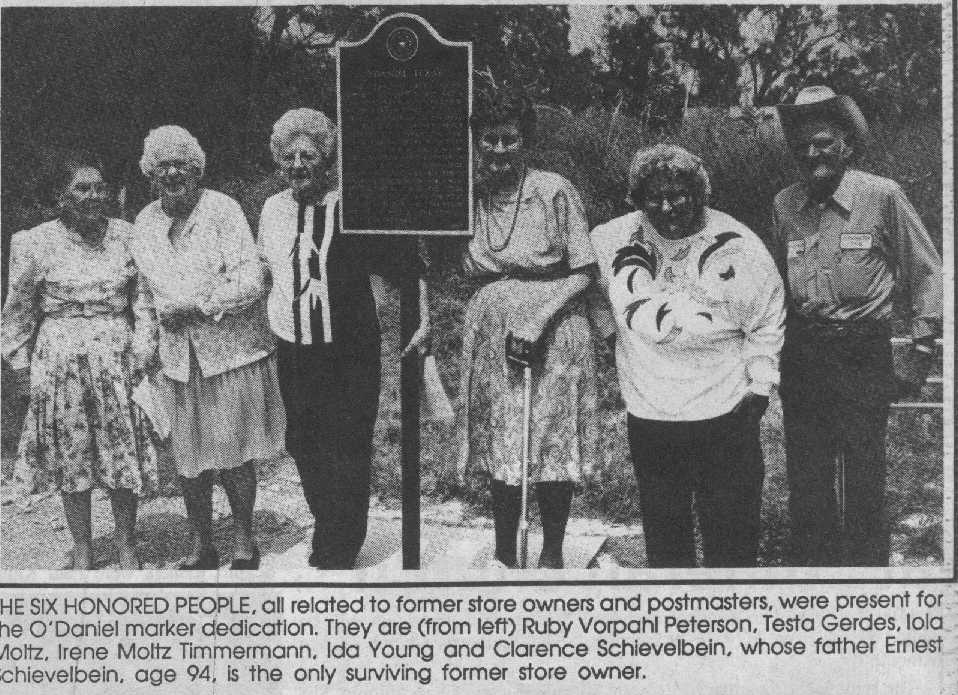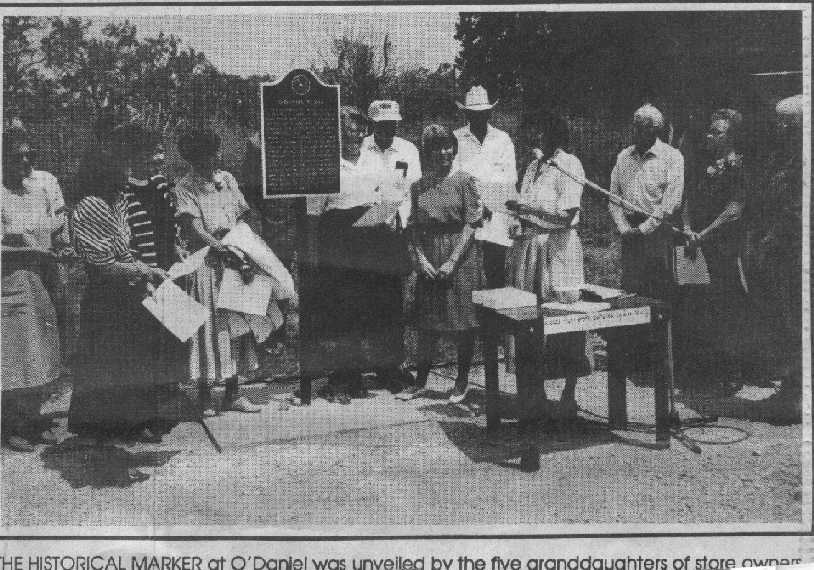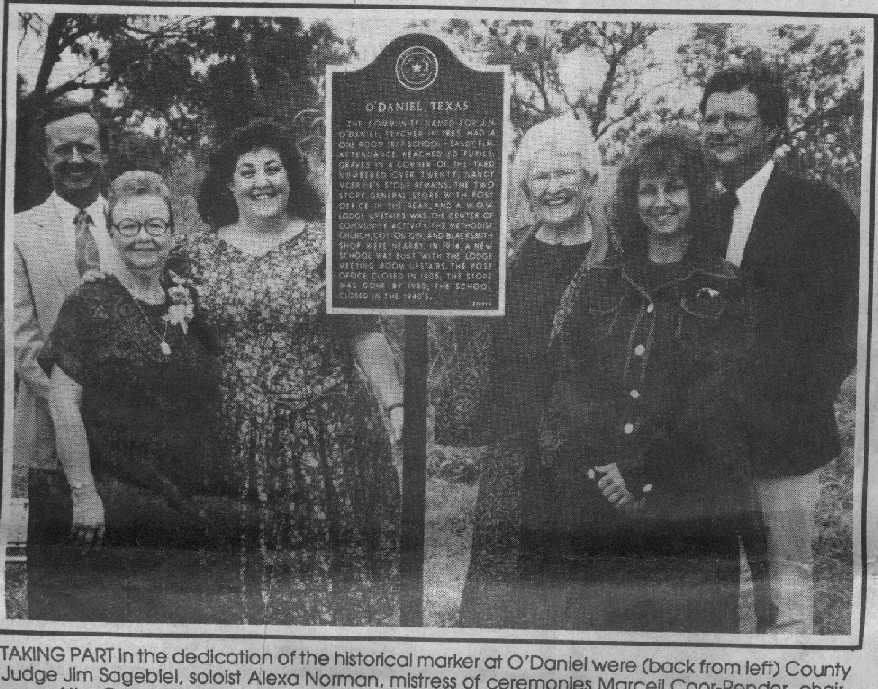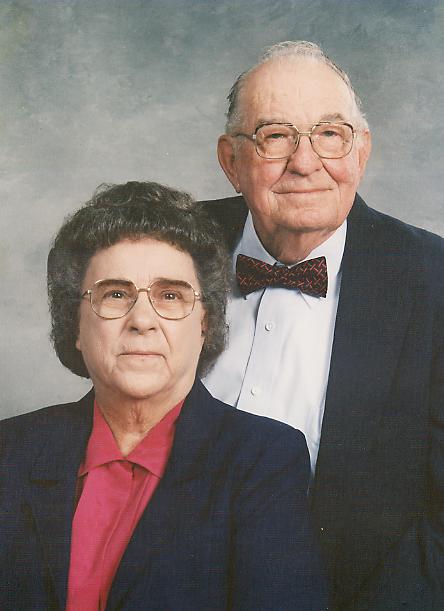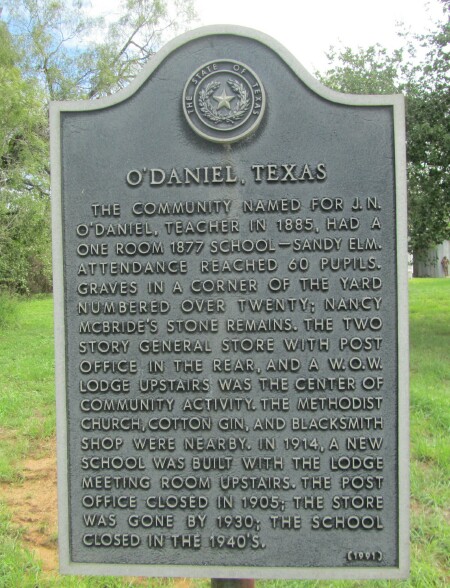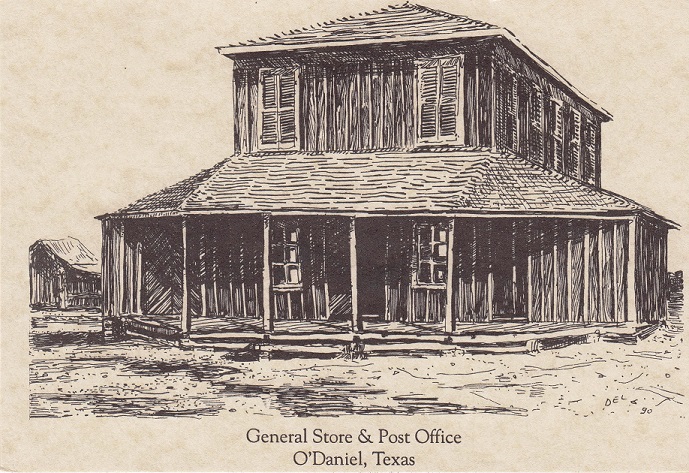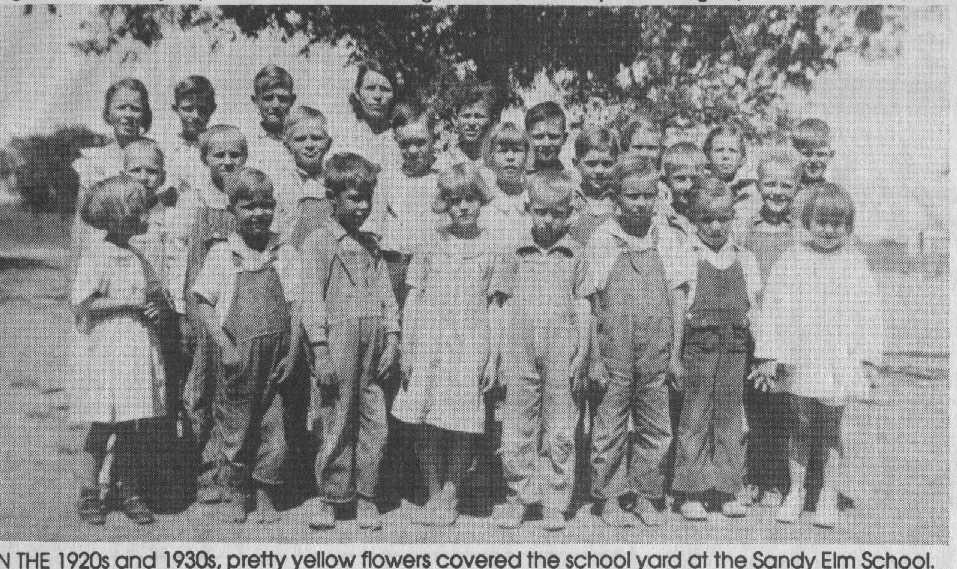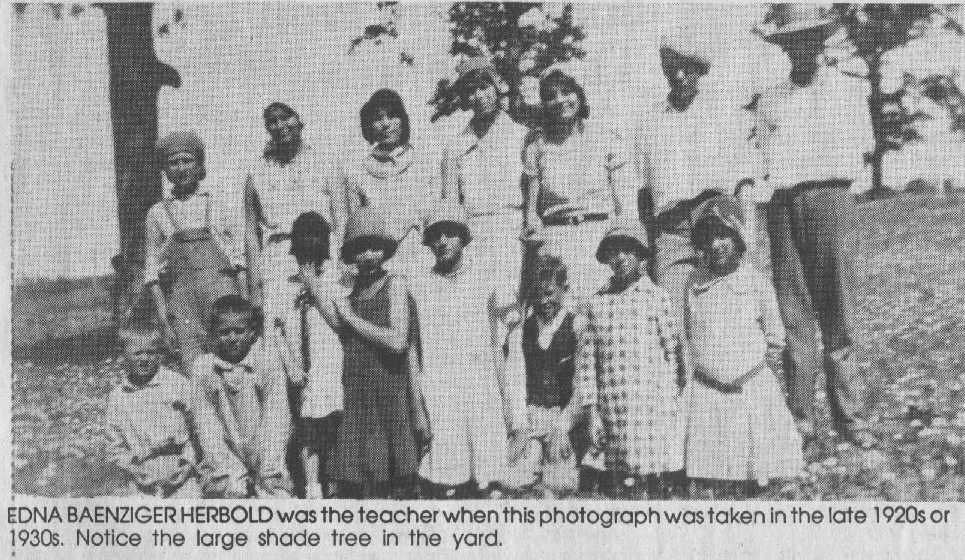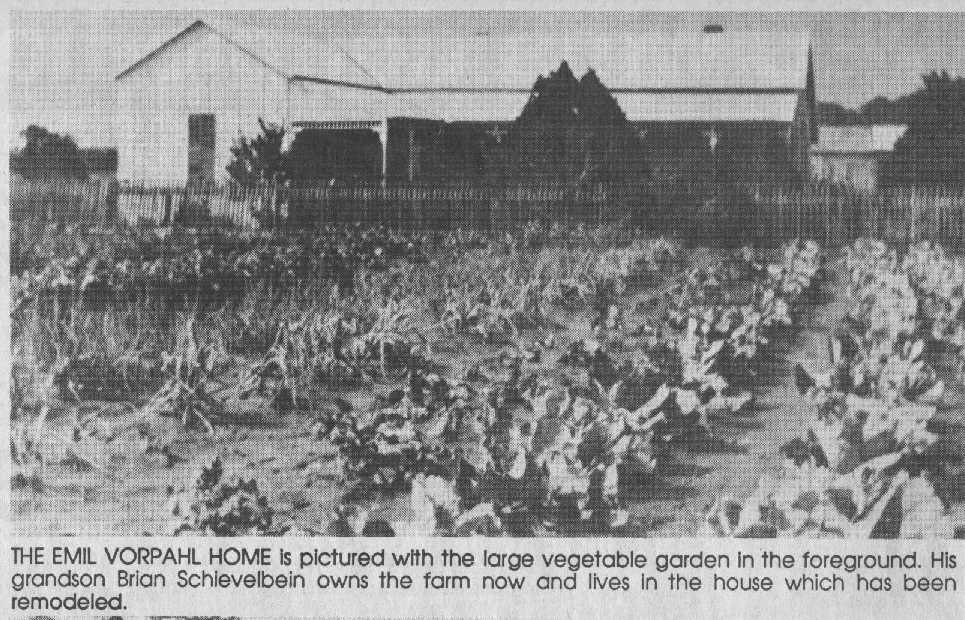[ If you have any information on O'Daniel, pictures or other items to share, I'd be happy to include them here ]
[Also, if you can identify any of the people in the pictures below, I'd love to add that as well]
O'Daniel, Texas
O'DANIEL, TEXAS. O'Daniel, twelve miles south of Seguin in southern Guadalupe County, was named for John N. O'Daniel, a teacher at Sandy Elm School in 1885.
1877 - The Sandy Elm School open to serve the community.
1886 - A post office was opened with the following postmasters:
Gerdes, Herman, 26 May 1886
Sanders, Andrew N., 21 Dec 1888
McGee, John P., 14 May 1898
Moltz Jr., Wm. H., 19 Jun 1902
Postal Service was discontinued 15 July 1905; mail transferred to Seguin.
By the 1890s the community had two cotton gins, four churches, a general store, and a population of 450.
By the 1940s there was no evidence of the community on county highway maps.
DIRECTIONS to O'Daniel from downtown Seguin: Take 123 south, and turn right on Farm Road 467. Turn left on to 414 County Road (Olmos Loop). On to O'Daniel (414 Road). Turn right on the 414A Road. Next intersection is O'Daniel (414 Road). The historical marker is on the left.
O'Daniel was the community that I grew up in, except that when I came along in 1959, it was no longer called that. I knew it only from stories that my parents told me. The stories of walking two miles to get to school (Sandy Elm) in O'Daniel. Climbing fences and walking through the neighbor's pastures, for the small kids, or riding the horse to school for the older kids.
The farm I grew up on was 100 acres situated 15 miles south of Seguin and 7 miles east of La Vernia. Coming from Seguin you would pass the communities of Sweet Home, Olmos and Elm Creek... or O'Daniel if you took the back roads to get to my house. We lived on the edge of the "Sand Hills"... the ground was certainly sandy, but there were very few hills. Going from our house past O'Daniel the road got smaller and turned from gravel to sand and eventually dead ended back in "The Sand Hills" where I was told that no one knew who owned the land back there and so it was called "No Man's Land". Somewhere back there were communities called Jake's Colony, Black Jack Springs and Nonny Nock. On the way to the Sand Hills you passed an old shack that was now abandoned, but I was told that Molly Pitts used to live there. She was an old black lady that was the area Mid-Wife and she helped to deliver most of the babies back before my time.
Bear with me as I reminisce a bit about the neighbors. As a child there were fewer neighbors. No mobile homes or pre-fab houses. The farmers all knew each other and many were related. My Grandfather Bruno Poenitz and his brother-in-law Ed Schraub purchased 200 acres of land from the Montgomerys shortly after 1900. This way their wives, who were sisters (Emma and Rosa Vorpahl) could live near each other. Ed took the southern 100 acres and Bruno the northern 100 acres. Ed fixed up the old house on the property and Bruno bought the chicken house from him and moved it to the top of a hill on his property and since Bruno was a carpenter, he turned that building into a kitchen and then added 5 more rooms as the family grew. This is the same house that I later grew up in. Across the road from the Schraub place was the Maddox land. They had been in that area for many years prior to my family moving there. Across the road from us was the Volkmann property. Down the hill from us was the large Fieselmann place. Mr. Fieselmann didn't live there anymore... he had moved to Mississippi or Alabama and would come to visit once a year or so. He owned a toy store, so I was always excited because he would bring me a box of toys. This was a luxury that I wasn't used to, so I looked forward to his visits. His land bordered on Emil Vorpahl's place. Emil was dead by the time I came on the scene but his daughter Julia Vorpahl-Schievelbein lived there. Once you were on his place, you were deep in the O'Daniel community. My Dad would tell me where the school used to be... nothing to see there, but a couple of grave markers. The store and the cotton gin were long gone too. The old Lambrecht house was still there and Standfield Volkmann lived in there and we used to go to visit him. Probably what stands out in my mind the most about O'Daniel was one of the residents that still lived there. His name was Eddie Norwood. He lived on a small plot of land (2 acres I think) that he and his family owned right there on the corner where the creek (just a dry low spot on the road most of the time, unless a heavy rain fell and then it prevented you from crossing the road) crosses from the Vorpahl place into the Kleinschmidt property. There was an old unpainted building on there. It was the size of a smoke house or a wash house... and probably WAS one of them originally. It was where Eddie lived. He lived there with his brother Willie, who had died before I was born. There was a fascination about Eddie... I was terribly afraid of him and intrigued at the same time. He had no electricity in that "room" where he lived and no running water. He was a black man... I really don't know his age.. he was always unshaven with a scraggly gray beard and few teeth. He was older but whether he was 50 or 70 when I was a kid, I don't know. He never took a bath, so there was an odor about him, but even more he smelled like smoke from "cooking" in his "room". So far he was just a normal farmer in that area, but what set him apart and scared me was that he had no legs. Just a couple of stumps wrapped in burlap sacks. He would hobble around on his hands and stumps to get around. When he talked it was difficult to understand because of the missing teeth. I enjoyed going to visit him with my Dad. We would take him food from the garden or whatever we had to share with him. He had other people that bought groceries for him, so he wouldn't starve, but we would check up on him to make sure he was OK. My sister worked for Sunshine Biscuit Company and often brought home damaged cookies boxes and we would share this luxury with him for special occasions. He was always happy to see us and I don't remember him complaining about anything. Some charity organization from Seguin came out and built him a new "house" during his last years, but although I think he appreciated it, he still preferred the little hut to this modern room. He died after I left home for college and so I never got to grieve the loss of his life. I think knowing him taught me lessons that I never realized at the time.
When I visit "home", I still enjoy driving around and checking out the countryside. Some of it looks like it used to and other parts have been changed by city folks moving in with mobile homes after the land has been sectioned off and sold. This community was very dear to my forefathers so I want to preserve its memory here on this web page. If you know any other facts, have stories to add or have pictures of the area, please let me know and I'll be happy to include them.
On March 14, 1991 thru April 21, 1991 the Seguin Gazette-Enterprise ran a series on the O'Daniel Community. The pictures were collected from descendants of the families that lived in that area and the stories were compiled and written by Nelda Kubala. With her permission I am copying these articles to the Web so that they can be beneficial to others and via these pages, the people that worked so hard to create that community can live on.
O'Daniel Community of early years gone, but not forgotten.
Thursday, March 14, 1991, page 13O'Daniel, a community located 12 miles southwest of Seguin, began with the public free school, called Sandy Elm in 1877. Soon, a general store with post office in it, a cotton gin, blacksmith shop, Woodmen of the World Lodge and Methodist Church followed. Dedication of an historical marker for O'Daniel is set for April 21 at 2p.m. Nelda Kubala has been researching the O'Daniel story and has gathered pictures and written stories about the community for the Gazette-Enterprise and the marker. The series begins with a summary of the community.
The community of O'Daniel, 12 miles southwest of Seguin, boasted a general store, post office, church, school, cemetery, cotton gin, blacksmith shop and lodge.
Some of the names familiar there were Whitby, Conley, McKay, Sellingsloh, Waiters, Richardson, Moltz, Vorpahl, Lambrecht, Jackson, Ploeger, Poenitz, Schraub, Hoermann, Sanders, Markgraf, McGee, Coor-Pender, Schievelbein, O'Daniel, Baker, Gerdes, Norwood, McIntyre, Dickenson, Volkmann, Werner, Rux, Kleinschmidt, Reece, McBride, Anthony, King, Hanz, Hemphill, Lenz, McClaughtery, Anderson, Young, Smith, Morgan, Vader, Warncke, Cockrell, Curry, Pitts, Gibbons, Herbold, Springs, Maddox, Conner, Whitehead, Rankin, Krenz, Reiley, Mueller, Strey, Block, Hurley, VanSyoc, Ayers, Steubing, Hill, Brown, Turppa, and many more.
Public free school began in Guadalupe County in 1877, and Sandy Elm School at O'Daniel began that year. The school got its name from the Sandy Elm Creek which meanders through the community. Eunice Whitby was the first teacher and her starting salary was just under $30 per teaching month. There was no teacherage; the early teachers boarded close by and walked to school; the later teachers drove. The grades were one through seven and there was only one teacher.
By 1885, there were over 60 pupils enrolled in this one-room frame school house. The teacher was J.N. O'Daniel, a 30-year-old native of Louisiana. He came to the community from the northeast part of Guadalupe County where he had taught at Highsmith and York Creek schools. It is for him that the community was named.
In 1914, another school house was built. It was a two-story frame building with the upper story housing the Woodmen of the Worth Life Insurance Society. In early days there were no lights; later, gas lanterns were purchased by the school for night use. Well water was plentiful, trees and flowers enhanced the rural school with much beauty, and pupils enjoyed walking to and from school, a distance up to five miles.
At school, sports and games were greatly enjoyed and made learning a lot more fun. The teacher was the coach, too, and school closed on Friday afternoon so the teacher could drive her team to the game.
With the coming of the automobile, and some families moving toward town, fewer pupils were enrolled at Sandy Elm. The county varied between 60 and 40 to 25 and less in number, and by the mid-1940s it was annexed with Elm Creek School, and the pupils were bussed there until the close of the 1963 year, when Elm Creek was closed and pupils were bussed either to the La Vernia or Seguin systems.
In the far corner of the Sandy Elm school yard there was an old cemetery with an iron picket fence around it. There were more than 20 graves; at present, the only headstone that can be seen is that of Nancy McBride, 1873-1880.
The general store at O'Daniel with its United States Post Office, was the center of the community life. It was a large two-story farm building with a front porch. The post office was in the back of the store. Postage stamps could be bought, packages and letters mailed and received and there were a few individual post office boxes that could be rented. A variety of goods were available in the store, including food, household items and tools for the farm. The supplies were bought from a wholesale dealer, at first picked up and hauled by wagon; later they were delivered out there. Store hours were long and business was good from 1886 until the late 1920s, and in 1930 the general store was closed and the building was torn down.
Store owners and postmasters were: Herman Gerdes, 1886-1888; Andrew N. Saunders, 1888-1898; John S. McGee, 1898-1902; and William H. Holtz, Jr. 1902-1905.
The United States Post Office at O'Daniel discontinued its service in 1905, and then mail was delivered RFD from Seguin.
The general store continued with Will Moltz running it until he sold out to Emil Vorpahl. both of these men also managed the Kott-Wiseman Gin for a time. It was during Mr. Vorpahl's time that the store was remodeled and the upper story was removed.
All the store owners and their families lived in a four room house behind the store. Later, the Will Moltz family bought land and built a large home a short distance down the road and farmed.
The Emil Vorpahl family, a household including 10 children, owned the farm across the road. Mr. Vorpahl sold the store to his son-in-law Ernest Schievelbein, who is the only surviving former store owner, and at the age of 94 now lives in Beeville. [Ernst Schievelbein died August 15, 1991]
Mr. Schievelbein sold the store to Joe Young, whose family the Fred Youngs, lived across the road to the northwest. Joe Young owned and operated the store until 1930. The community had come to hard times by then, families charged supplies from crop to crop, and the depression was felt at O'Daniel too. Cars and trucks took people a further distance to shop, and so it was that the general store was really no longer needed.
The Woodmen of the World Lodge continued in the upper story of the Sandy Elm School from its charter date Aug 18, 1898, until Feb 16, 1940, at which time members of Lodge #299 consolidated with other chapters or dropped their membership. The lodge was a fraternal order and in the early 1900s an organization called Grove was established for the ladies. Later they joined with the men.
The community of O'Daniel thrived in the late 1800s and early 1900s, and by the mid-1920s when cotton was king in Guadalupe Country, farming was at its peak.
The Kott-Wiseman Cotton Gin at O'Daniel was very busy as cotton grown in that part of the country was ginned there.
The blacksmith shop, owned and operated by the Tom boys, Howard and Will, was also a busy place because farming was done with mules, people rode horses, and farm tools needed attention. Antone Markgraf was a later blacksmith there; and still later Otto Bloch ran the shop.
The Methodist Episcopal Church South was organized about the time of the general store and was a close neighbor. There was a sizeable church, with its own parsonage and pastor for a time. It was organized as a sister mission to the Elm Creek church, by the Cibolo Methodist and part of the time, they shared pastors. Just before 1920, when membership in the O'Daniel church declined, the church closed, and the building was sold and torn down.
Today there is little evidence that O'Daniel even existed and that it once was such a lively, thriving community. Driving along O'Daniel Road today one can only imagine the once busy, exciting life of the store, the school, the church's Sunday school picnics, the smell of cotton lint in the air, the pounding of the blacksmith's hammer, the favorite swimming hole, the cool waters of the spring, the tree under which 15 cent haircuts took place on Saturdays.
Nothing there but memories, and they will live on forever.

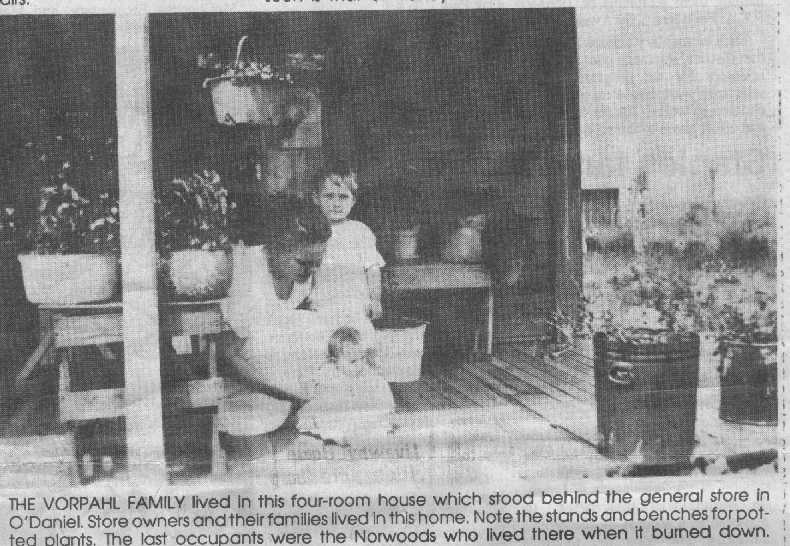

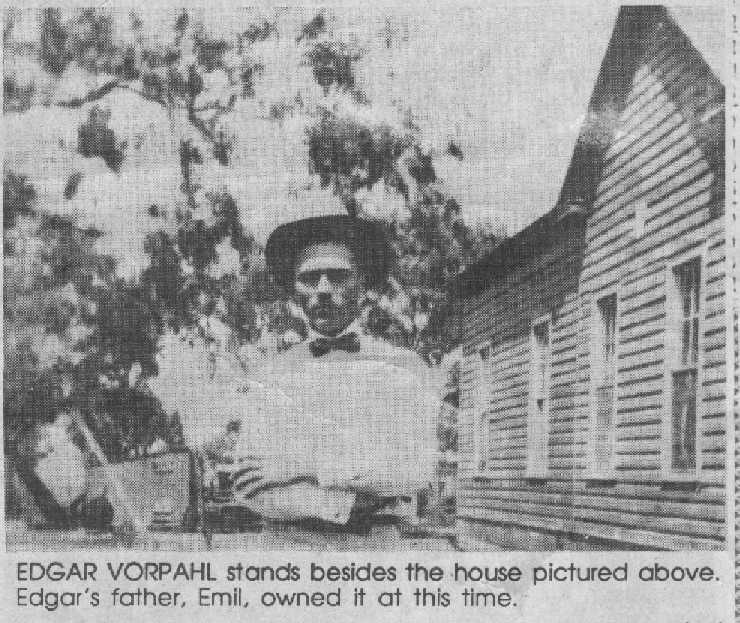
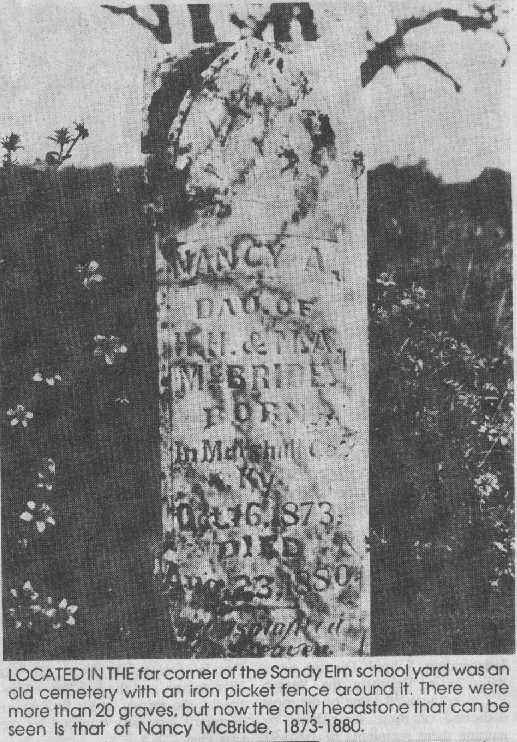
O'Daniel's general store owners lived in nearby home
Sunday March 17, 1991 Page 8BThe general store at O'Daniel was a large building with front porch and an upper story which housed the Woodmen of the World Lodge.
There was a home behind the store where each family that owned the store took residence. A dug well supplied them with water for family, store and a bucket of water each day for the school nearby.
United State postal records show that a post office was applied for and in 1886 it was granted. The post office occupied a small portion in the store where there was an office and a group of individual boxes to rent. Postmasters and store owners are listed as follows: Herman Gerdes, 1886-1888; Andrew N. Sanders, 1888-1898; John S. McGee, 1898-1902; and William Moltz Jr., 1902- 1905.
The United States Post Office at O'Daniel was discontinued in 1905 and mail was delivered RFD from Seguin.
The general store continued with Will Moltz as proprietor until he sold out to Emil Vorpahl. The Vorpahls owned the farm across the road from the store, but moved into the home behind the store after the Moltz family moved into their large home just a short distance from there. Mr. Vorpahl made a smaller building out of the store by tearing down the upstairs.
Emil Vorpahl sold it to his son-in-law Ernest Schievelbein.
He sold the store to Joe Young, who operated it until 1930 when business there began to decline. When he closed the store and moved to Seguin, he tore down the building and used the lumber for buildings at the new location. He sold the five acres where the general store, post office and home behind the store had been to the Norwood family.
Willie and Eddie Norwood lived in the home where a fire destroyed it. A smaller home still stands there today. The land is in the Norwood estate, and Ruby Franks is administrator.
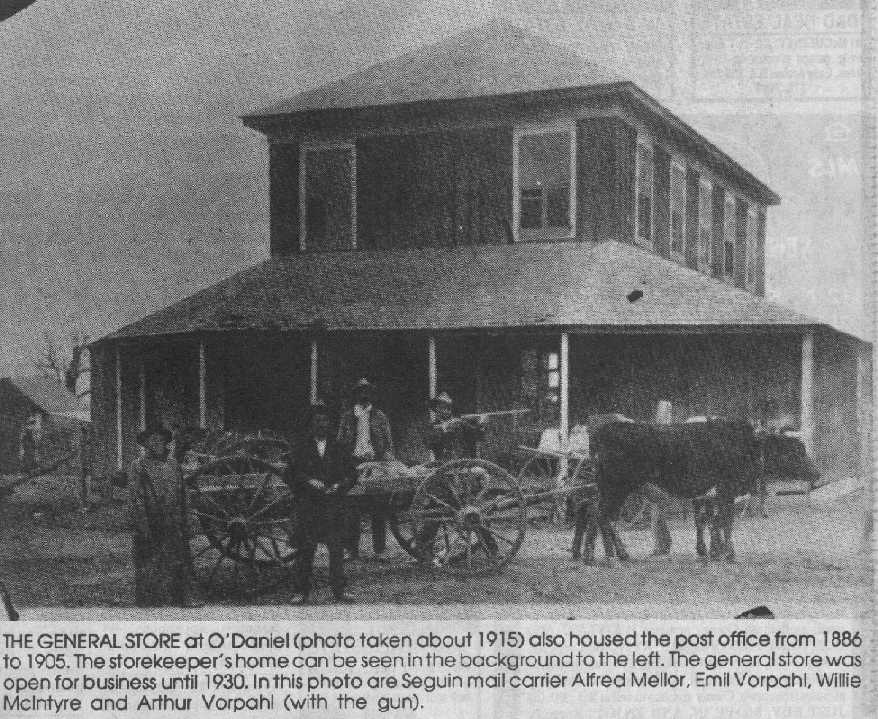
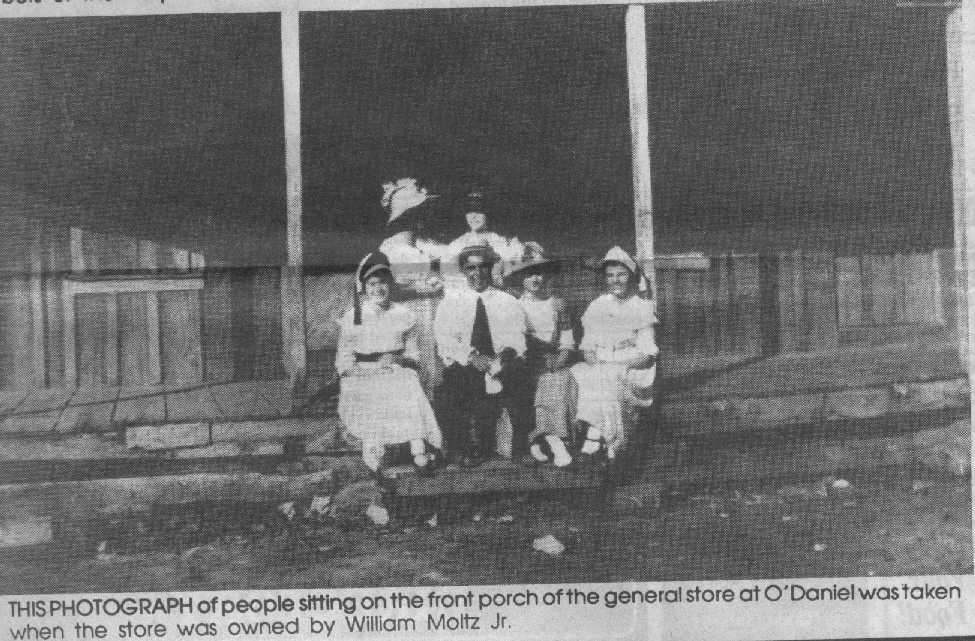
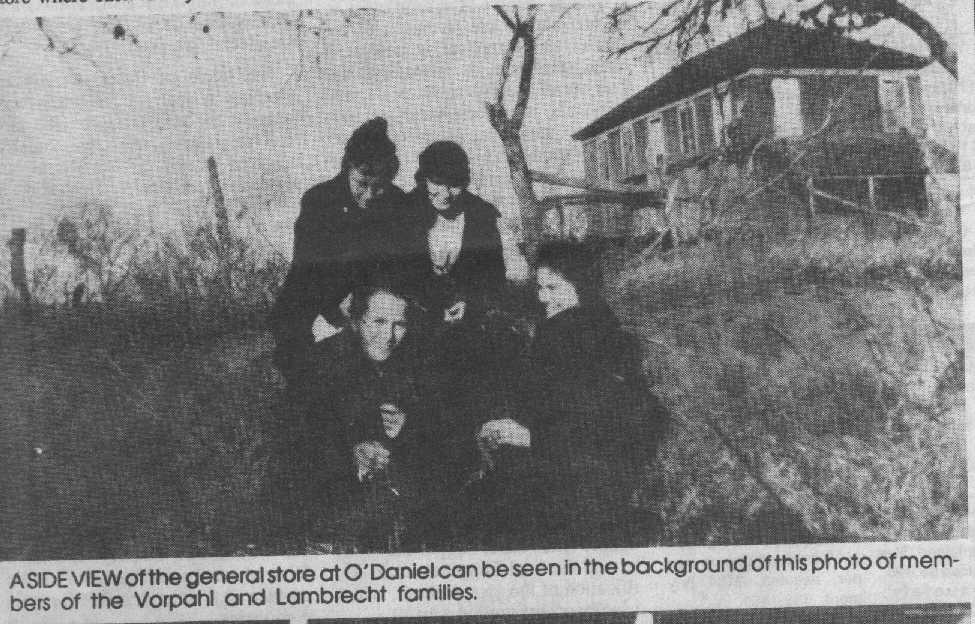
Son remembers father's trips to O'Daniel to deliver mail
Thursday, March 21, 1991 Page 13The community was well established when application was made for a United States Post Office at O'Daniel.
Public free schools had sprung up every five or six miles apart and Sandy Elm School opened its doors at O'Daniel in 1877. The general store, a large two-story building, was in the heart of the thriving settlement, and the Post Office was placed in the store in 1886. Postage stamps could be bought, letters and packages could be mailed and received, and individual mail boxes could be rented.
The postmaster was Herman Gerdes, who came to O'Daniel from neighboring Elm Creek, just eight miles away. There was a home behind the store and Gerdes lived in it, as did succeeding postmasters and store owners.
There were four postmasters from 1886-1905. Postal service at O'Daniel was discontinued July 15, 1905 and mail was delivered from Seguin.
Gerdes was appointed postmaster May 26, 1886; Andrew N. Sanders on Dec 21, 1888; John S. McGee on May 14, 1898; and William H. Moltz Jr. on June 19, 1902.
George C. Mellor wrote the following about his father Alfred Mellor who was a mail carrier.
"My father Alfred Mellor carried the mail from the Seguin Post Office to O'Daniel while serving his rounds on R.F.D. #6. This route was about 25 miles long and O'Daniel was about halfway. Alfred Mellor carried this route from 1906 until 1933.
I went with my father many times as a young boy and it was always a thrill to get to O'Daniel where Mr. Joe Young, the proprietor of the store, would get me a cool bottle of pop.
For many years my father used what was called a jumper, this was a two-wheeled gig with hardboard seat and barrel-staves for a floor, no top but, sometimes he used a tremendous umbrella to keep the sun off. He had another horse stationed about halfway so he could change horses.
When the weather was real bad, he would ride horseback for four or five days at a time. He would wear a rain coat called a pancho and carry the mail in saddle bags. All for $750 per year. And furnish your own equipment.
Later sometime after World War I he bought a second hand Model T-Ford touring car. As time went on he had to keep buying the older Model-T's because the width between the wheels was the same as that of a wagon or buggy, this being necessary to be able to stay in the same ruts.
The roads were hell. Sand and clay. In the summer the deep sand would cause your wheels to sink in deep if you were not experienced in driving in sand. When it was wet and icy, you would slip and slide in the clay.
And houses were few and far apart. The mailman would also tell the doctor what the symptoms were of some sick patron on the route, and the good doctor would prescribe a medicine and the carrier would deliver same to the patient the next day.
In those days in this part of the country, people didn't go to town any more often than once a month. Most of the people on this route were poor people, by today's standards. They would do a lot of trapping stretch the hides on boards and Mr. Mellor would bring the hides to the American Railway Express Office and ship them to Montgomery Ward & Co.
One area on this route was Jakes Colony. The carrier would do anything he could for all his patrons and, he in turn, had a standing invitation to enter any farmer's field and pick tomatoes, corn, cantaloupe and watermelons or whatever. He was also allowed to go bird hunting anytime, anywhere. In those days the sand hills were full of quail and dove. Them was the days!"
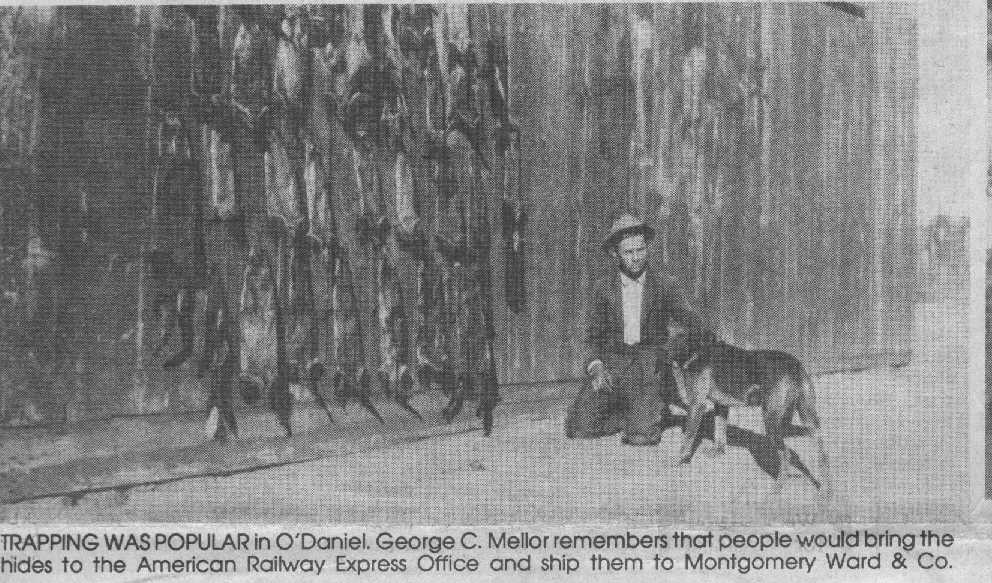
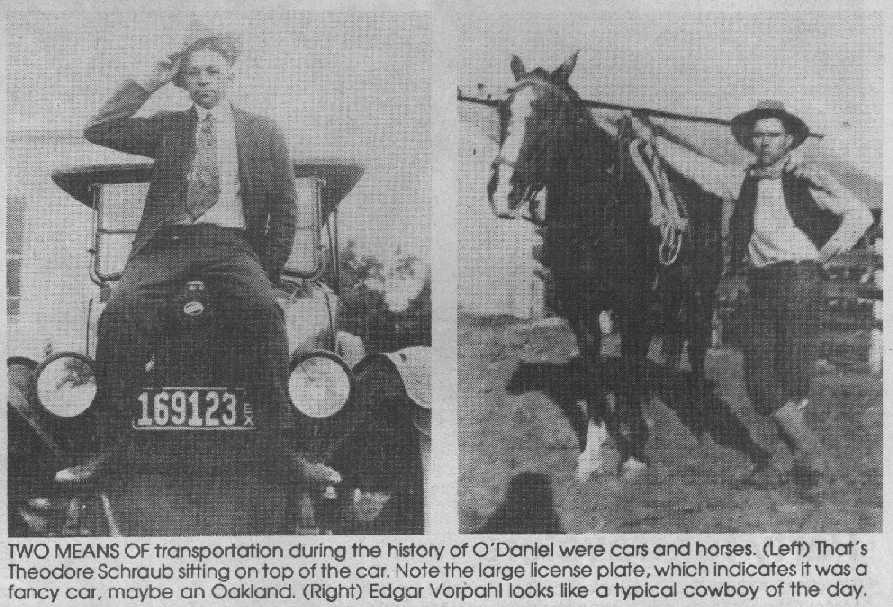

O'Daniel community attended services in its own church
Sunday, March 24, 1991 Page 9AMethodism came to Texas as early as 1840 with the influx of German immigrants to Texas, when a Methodist church was organized in Galveston.
By 1850, there was a Methodist church in its own building in Seguin. After this, Methodist missions sprang up all over South Texas.
By 1873, the Methodist Episcopal Church South of Elm Creek came into being.
This community of believers, known as a mission of the Cibolo church, had as its first regular minister the Rev. J. Bader of new Braunfels. By 1888, the congregation rose to quite an adequate charge and built its own church building, brush arbor, shed for the horses, outdoor toilets, and parsonage, and for a time had a resident minister. This was an exciting time for the Elm Creek community, and a busy time. Saturdays were spent, in part, preparing food for Sunday's carry-in dinner. Then on Sunday morning the food had to be reheated, as there was no refrigeration of any kind in church or home in those days.
Early on Sunday morning, before the wagon or buggy ride to church, everyone dressed in their Sunday best, which for the ladies included hats, gloves, and high-top laced or buttoned shoes.
The ringing of the church bells, could be heard for miles, and people, upon arriving, filled the pews, ladies on the left, gents on the right side of the aisle. Sunday school and morning worship, with the singing of many memorable Methodist hymns, filled the morning.
A delicious dinner, which always included meats, vegetables, breads, relishes and prize-winning cakes and pies, was served under the brush arbor or under the trees. There were tables and benches fastened to the trees and also a platform used for outdoor meetings and programs which were held immediately after dinner.
The young people belonged to the Epworth League, the men met in business session, while the women cleaned up after dinner. Then, usually cake and coffee or lemonade were enjoyed before they started home.
Before the 1890s there was a sister mission at O'Daniel. It was fashioned after the Elm Creek church and was also a charge of the Cibolo Methodists, shared the same minister and they often worshipped together, being only about eight miles apart.
The Methodist Episcopal Church South at O'Daniel built near the general store, had its own parsonage and resident minister, when it was strong, and later visited to worship at Elm Creek. On Sundays when no minister was available for them, the Sunday school superintendent was in charge.
All the rural Methodist churches in the area were similar in style and structure. They were built of wood, with a wood shingle peaked roof and wooden tower to house the bell, and had shuttered windows. They were wood heated and had no electricity. Later they used kerosene lamps. One reason they looked alike is that most of them were built by Herman Gerdes of Elm Creek, with the help of members.
From 1904 - 1907, the decline of the two missions made it necessary for them to unite (1907-1919), during which time the O'Daniel congregation become weaker. At first during this time, they were served by the New Braunfels minister, then for one year by the First Methodist Church South of Seguin, and were dissolved as a congregation in 1920. Many of the area people owned automobiles by this time, and they drove to Seguin or joined neighboring La Vernia's Methodist Church, which was also formed in the 1879s.
The O'Daniel church building was sold, torn down, and the materials, even the pews, were used to build a residence for Paul Vorpahl in La Vernia. It is still used as a home today. The land were the O'Daniel church stood is owned by the Streys.
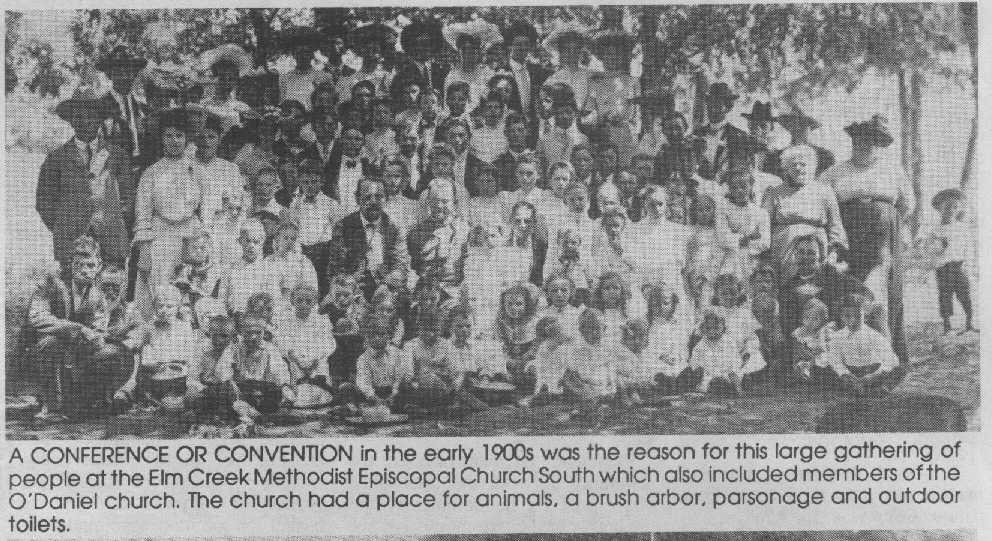
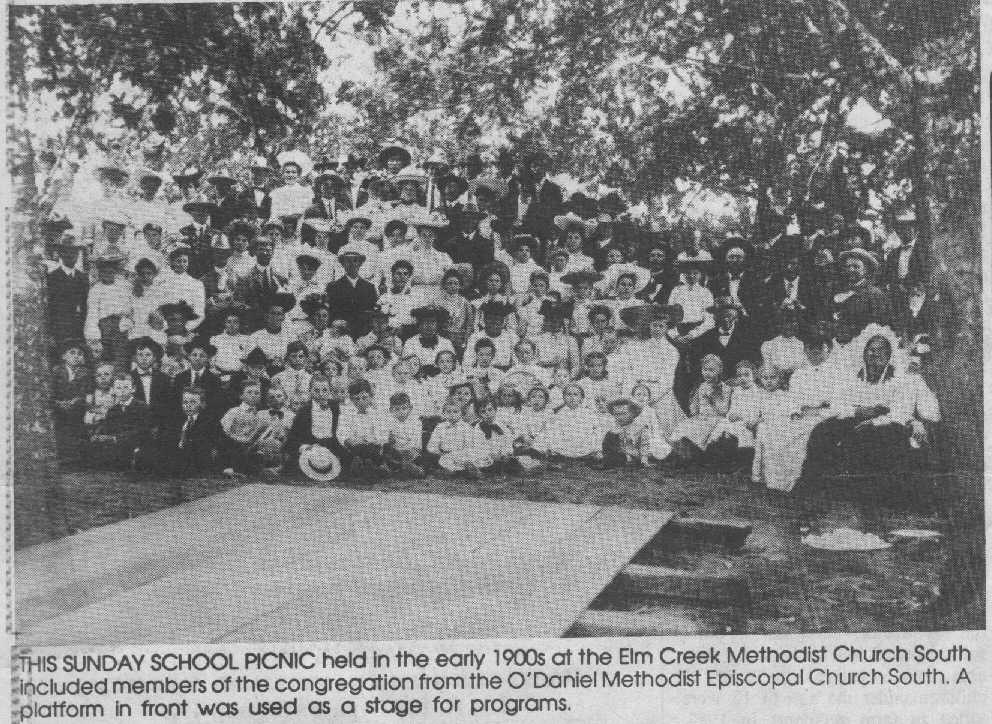
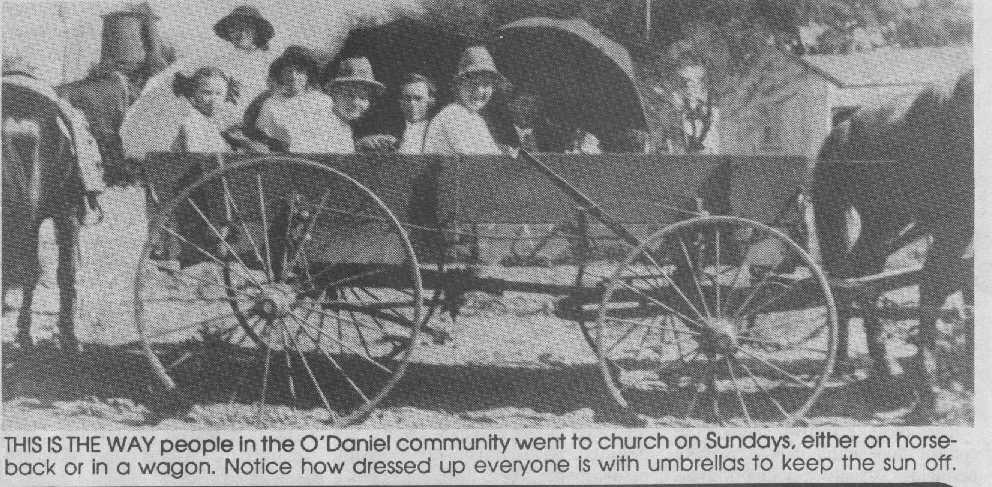
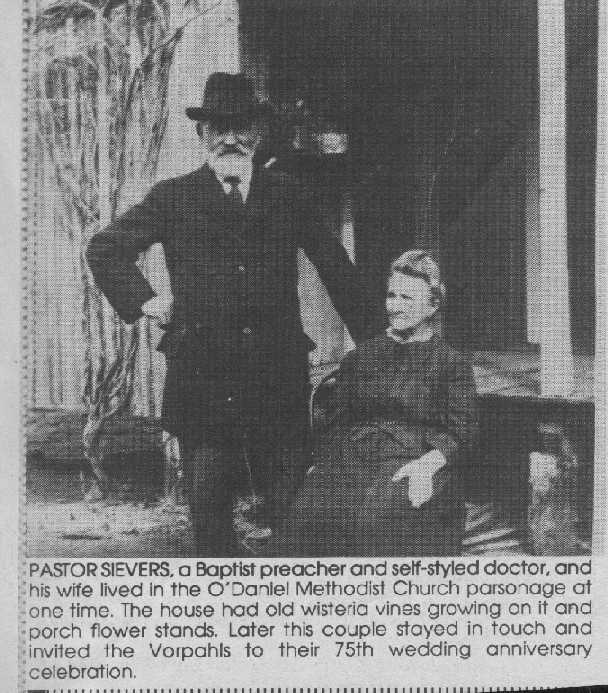
Kott-Wiseman gin flourished when cotton was king
Thursday, March 28, 1991 Page 13Cotton was grown in Guadalupe County for many years before the turn of the century. Oxen-driven wagons and later horses were the mode of transportation. When a wagon was filled with cotton, the farmer drove it to the nearby gin.
When cotton was king in Guadalupe County in the mid 1920s, there were cotton gins every five to 10 miles apart, and many small communities had more than one gin at a time. The farmer drove his wagon, and later truck, filled with cotton to the gin, it was weighed, he was paid for the cotton, and he was on his way back to the farm to repeat the process until the crop was all picked.
At the gin the cotton was ginned and baled, and the ginner then had to sell the seeds and the bales. There was a cotton oil company in Seguin that separated the final lint from the seeds and extracted the oil for shipping and sold the by-products.
There was also a compress in Seguin that reduced the size of the bales, and shipping by rail for both oil and bales were on the property. There also were independent cotton buyers in Seguin and San Antonio.
The Kott-Wiseman cotton gin was a typical country gin. Much work and excitement went into the growing of cotton in the county.
Growing and producing cotton was a family affair. The farmer planted the cotton in rows with a mule-drawn planter. Then, during the growing time (cotton is a warm-weather plant) the family -- many times the mother and children (boys and girls) too -- chopped the weeds so the cotton could grow. Besides chopping during the growing season, the farmer cultivated it with mule-drawn equipment. Premiums, were offered for clean cotton and also for the first bale grown in the county.
When the heat of the summer produced fields of white, the cotton was hand picked, also by the whole family. The long cotton cloth sacks were homemade and often-times patched and used until completely worn out.
Each picker dragged along such a sack, attached over the shoulder, picking the lint from the boll from two rows at a time until the sack was full. Every reader can readily remember the back-breaking experience under the hot Texas sun!
At the end of the rows the bags were emptied into the wagons. Sometimes there were job offers to "town boys," although many were discouraged because this was not an easy way to get rich quick in the summer heat, nor did the farmers have ready cash to pay.
When cotton growing in the community of O'Daniel waned and trucks were owned to drive the crops to nearby La Vernia or Seguin, the Kott-Wiseman gin was closed.
With the ownership of the family car and truck came the improvement and building of roads in the county. The narrow trails were widened and later topped with fire stones and gravel. At this writing, the state maintains the major roads; the county cares for the lesser roads. In a sudden downpour the traffic is still halted by the mighty Sandy Elm and Elm Creeks, although the runoff is fast.
For some years the gin stood idle, until Bob Stein bought it for parts for his gin at Elm Creek.
The location of the Kott-Wiseman gin was in line with the church, behind the general store in O'Daniel, and the land now belongs to the Norwood estate.
Near the gin was a large post oak tree, and folks today still remember the natural spring close by which provided them with a drink of cool, sweet clear water.
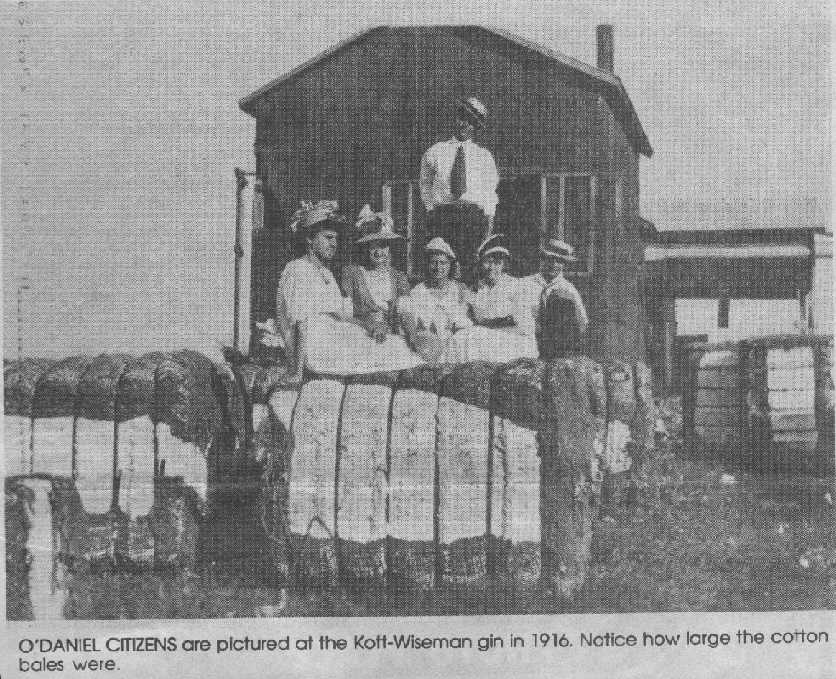
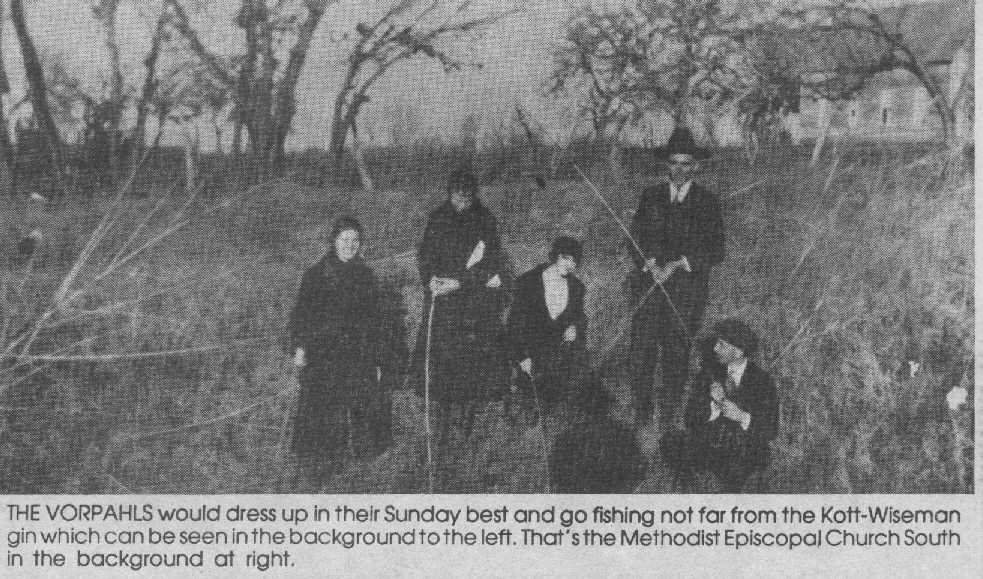
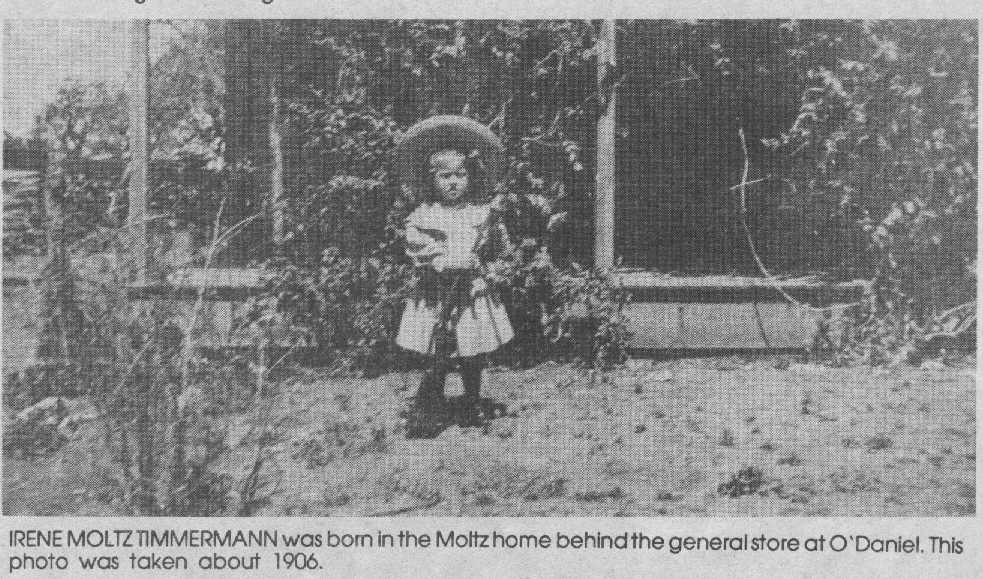
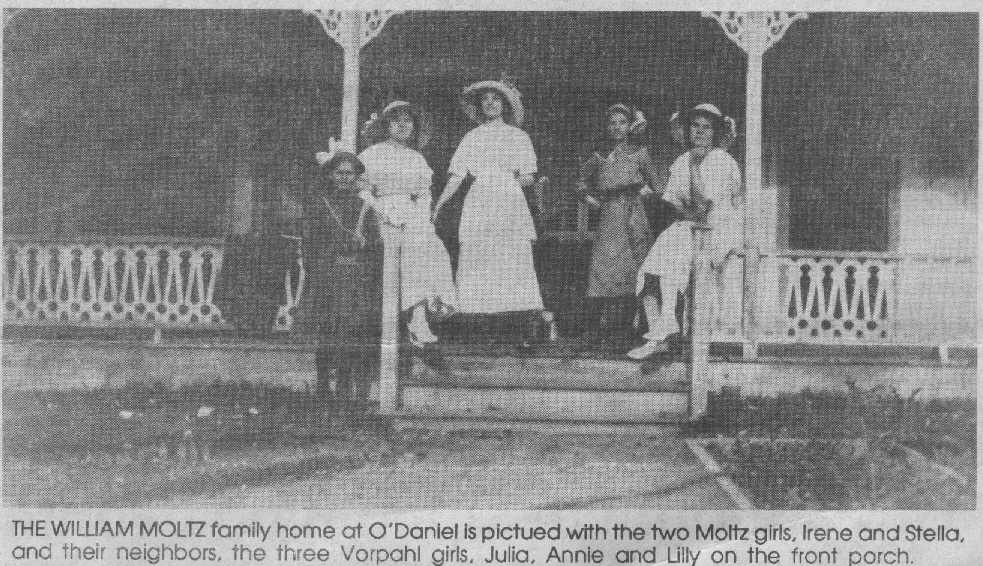
O'Daniel blacksmith kept busy by farmers using horses
Sunday, March 31. 1991 Page 10AThe Tom brothers, Howard and Will, were a part of the business and social life of O'Daniel. Will Tom was the blacksmith.
During the week, work at the blacksmith shop was steady. Horses were used on the farm by a lot of the area people, and keeping them shod was a real chore. Also keeping the plow points and other farm tools in good shape made additional work and income for the blacksmith. Will Tom's shop was near the general store, so it was conveniently located.
The pounding of the hammer on the hot steel could be heard at the school and all around O'Daniel. New farm equipment could be bought at the general store, but it was economical to keep the old in working order for years; thus the O'Daniel blacksmith shop thrived in the early 1900's and stayed in operation until about 1920.
The land today is owned by the Norwood estate.
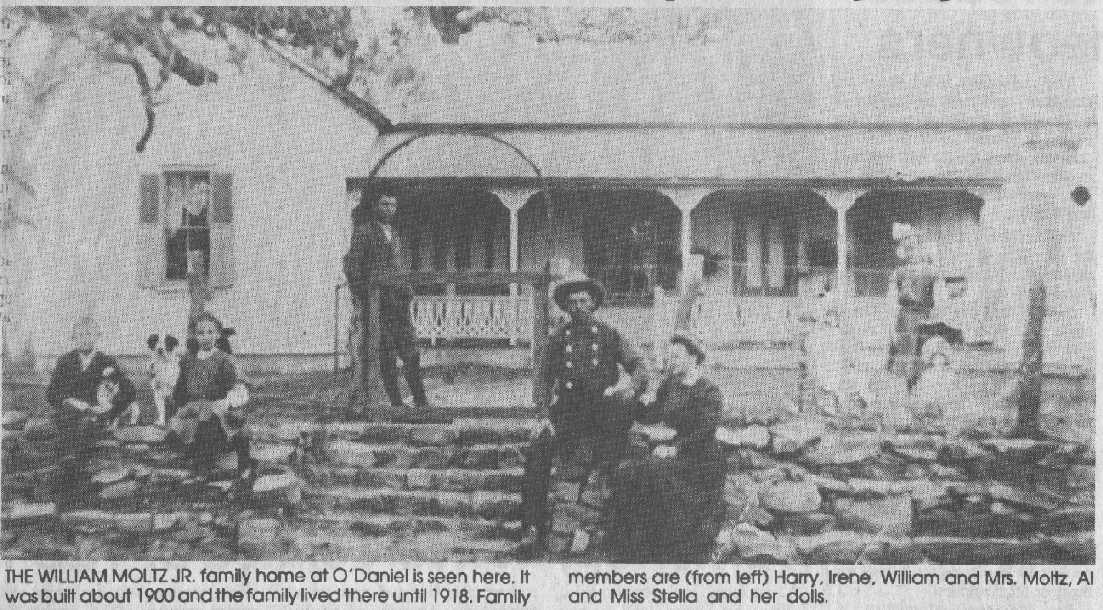
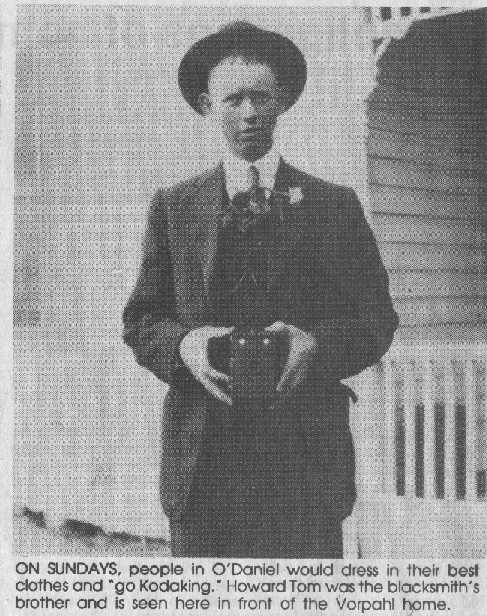
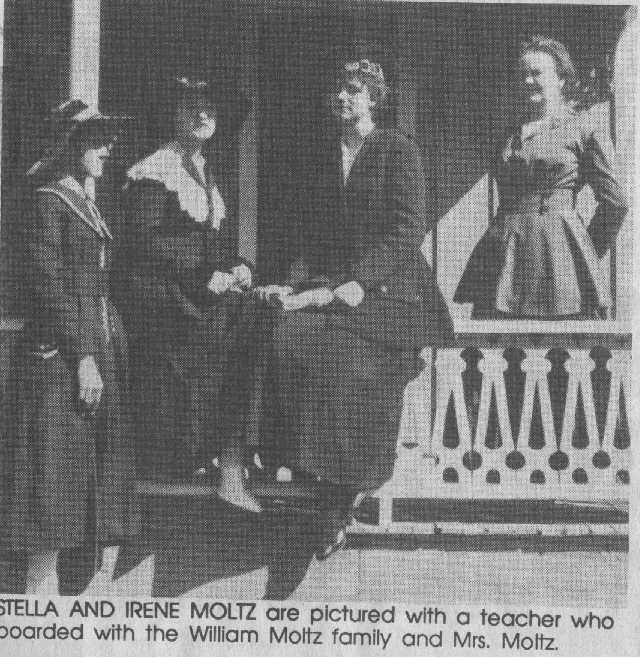
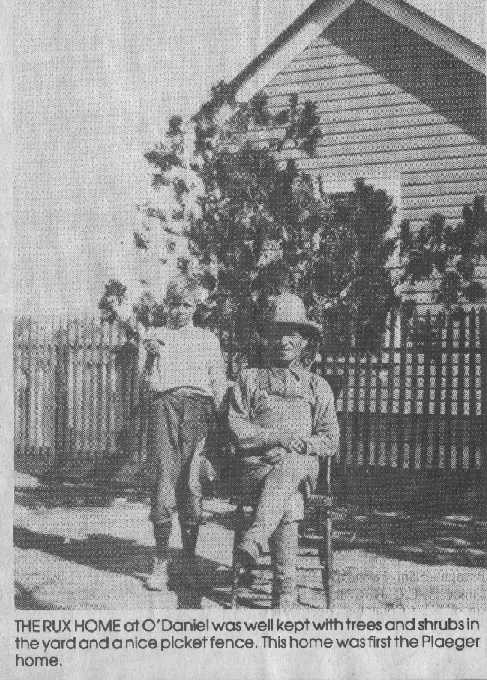
Children of O'Daniel enjoyed life at Sandy Elm School
Public free school in Guadalupe County began in 1877. Sandy Elm is listed in the record as starting that year with Miss Eunice Whitby as teacher. Her salary was almost $20 per school month, and the grades were one through seven.
The deed, dated the 2nd of May A.D. 1885, stated the 2 58/100 acres of land were bought from J.N. Conley and wife Sarah, for $2 for church and school purposes. It further stated that A. Maddox, J.N. Conley and Charles Sellingsloh were the trustees of Guadalupe County, Texas.
All that certain tract of parcel of land situated in Guadalupe County, on the waters of the Sandy Elm Creek about 12 miles south of Seguin, being a part of the Dominic Johnson Survey, was surveyed by A.M. Erskine Company.
The school house was a large one-room frame building set on piles of rocks and had white-stained six-pane windows, a front door and rock steps.
A large wood-burning heater stood in the center of the room, and in one corner on a small table stood the wooden bucket of water. The water was carried from the general store daily, a distance from the school, and the children used the common dipper for drinking.
The school house was surrounded by wildflowers most of the time, as the sandy loam produced bluebonnets, post oak pinks, and a variety of yellow and white flowers in profusion.
In one corner, toward the back of the school yard, there was a cemetery which was fenced with iron pickets. There were over 20 grave stones and most of the cement slabs were encrusted with sea shells. Oftentimes the school children picked wildflowers and placed them on the graves.
At this time, there is only one headstone visible, and it marks the grave of Nancy McBride and it reads as follows: " Nancy A., Dau. of H.H. & M.A. McBride, born in Marshall Co., Kentucky, Oct. 17, 1873; died Aug 23, 1880 - Transplanted in Heaven."
In early days, almost everyone walked to school, a distance of up to five miles. A few rode donkeys, and a place was provided for the animals. Often during a violent rainstorm, the heavy rains caused the Sandy Elm Creek to rise quickly and the children had to wait until the waters receded before they could continue their walk to or from school. The muddy roads were hazardous as well as the dry hot sands.
Behind the school house were the usual two toilets, one for boys and a little distance away was the one for the girls. There were no doors, but they had concealed entrances and accommodated the pupils with two holes, one a little smaller, and outdated Sears and Roebuck catalogs provided the wipes.
The one teacher of all seven grades was principal, nurse, custodian, record keeper for the local board, and for the county schools superintendent, counselor, and punisher for the naughty deeds.
Pupils could be expelled from school for using foul language or willfully damaging school property, and the teacher could punish pupils by making them stand nose in the corner for a given time, or make them write 50 or more times "I will not do...." whatever had been done, or give them a spanking or wash their mouths with soapy water for using dirty words.
Usually the teacher lived and boarded with a family who lived within walking distance from school. There was no telephone or other form of communication at school.
Going to country school was exciting and fun -- lots of fun. Walking, talking, and laughing as they walked to and from school, recess with organized games, such as hide-and-seek, bull-in-the-pen, drop-the-handkerchief, and jacks and mumble peg for individual fun all added up to wonderful times. Then there were the competitive, seasonal games such as volleyball, baseball, and basketball, and training for the track events. The teacher was also the coach, and on Friday evenings school let out early so the teacher could drive the team to nearby Neumann, Elm Creek or Leissner schools, and also to track meets in Seguin.
Lunch was brought to school in a tin bucket, box or paper bag. Some of it was eaten on the way to school or at recess. Lunch was eaten out-doors, under the trees. It usually consisted of several sandwiches made with butter and jelly or peanut butter and a piece or two of dry country sausage, seasonal fruits and vegetables from the garden were an added delight. The sandy loam of O'Daniel produced the very best tasting vegetables and fruits and were the sustaining commodities for the entire family. Eggs, fried chicken, beef or pork roast also were used with the homemade bread and butter lunch. Water from the well was the usual drink.
In 1914 a new two-story white frame school house was built. The old one was totally worn and after a while was removed. On the front of this new building the following was painted: "Sandy Elm School - 1914 - District 21." The upper story was occupied by the Woodmen of the World Society and was always kept locked during school hours. The letters WOW were clearly seen in the upper story front window. The lodge continued to meet there until Sandy Elm closed in the 1940s.
Beside the school house was an underground rainwater cistern. The guttered building supplied enough drinking water for the needs of the school. A hand pump readily brought a fresh drink into the cup of the individual. The ever-popular folded cup and later the tin cup with handle were used by this time. The cups were hung on the limbs of a tree or on a nail on the school house wall.
The two-story large one-room school house was rectangular in shape, larger than the earlier one. It too was heated with wood. There were more windows, and the steps and platform at the front entrance were used for a stage. Outdoor toilets with toilet paper, later on, and a shed for the animals complemented the campus. Later on, too, gas lanterns were bought and used for night meetings and programs.
School at Sandy Elm carried on as when begun, with few modifications -- one teacher for all the pupils in grades one through seven, except one year there were no first graders, and one year the top grade wanted to stay on. Pupil count varied from 62 to 40 to 20 or less. In the mid to late 1930s older pupils from Sandy Elm and Neumann were bussed to Elm Creek, and by the mid 1940s Sandy Elm School was closed. However, the annexation to Elm Creek lasted until 1963 - 64 when Elm Creek closed and all rural school in the area became a part of the Seguin or La Vernia systems.
Later the Sandy Elm School house was sold and torn down.
Some of the teachers at Sandy Elm from 1877-1940s were: Eunice Whitby, W.S. Hudson, Katie Bell, Maggie Leisering, John N. O'Daniel, J.A. Ghormly, August Klingemann, M.S. Gardner, R.B. Scott, Bess Gibbs, Mamie Smith, Edna Whitehead, Valena Hemphill, Zula Conner, Edna Baenzinger Herbold, Lois Springs, Helen Hoermann Kleinschmidt, Julia Anderson, Mrs. Gerald Maddox, and Mildred Mueller..
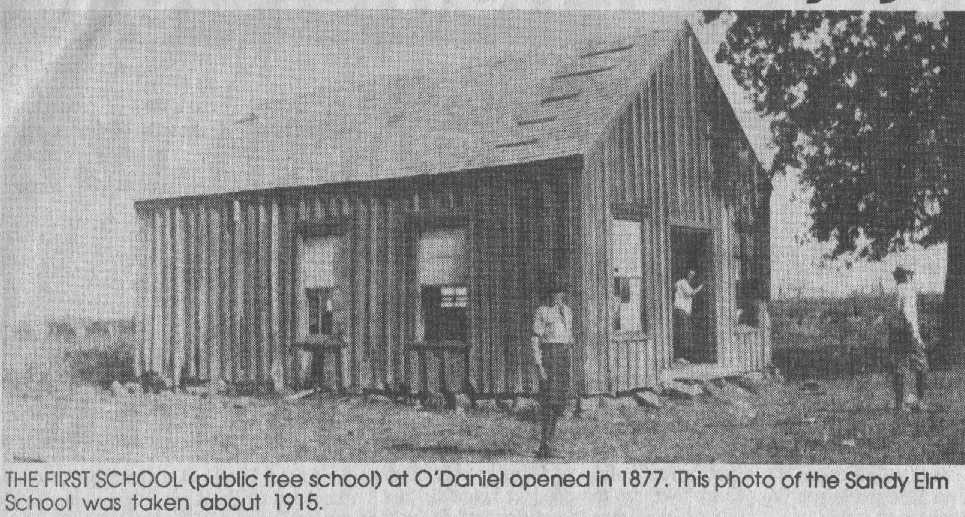
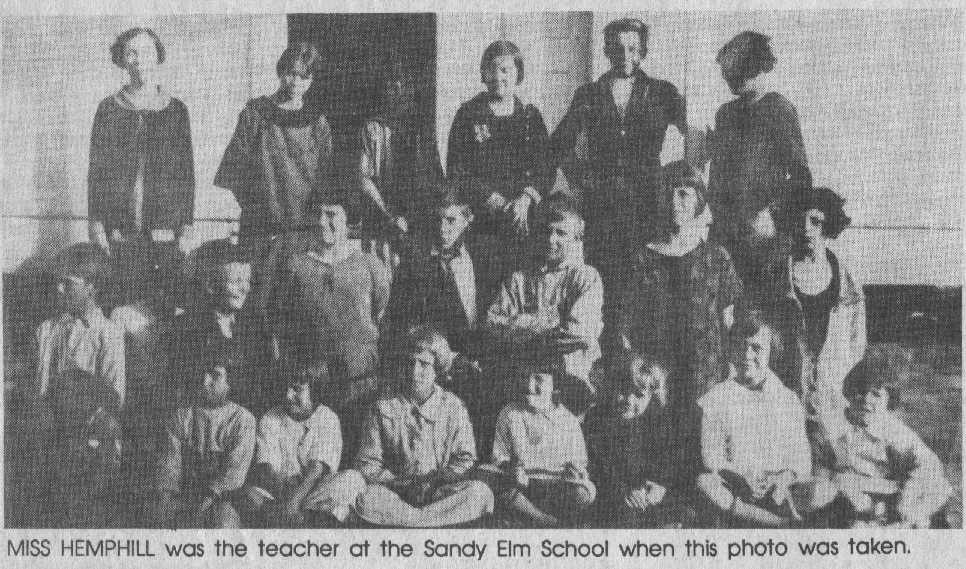
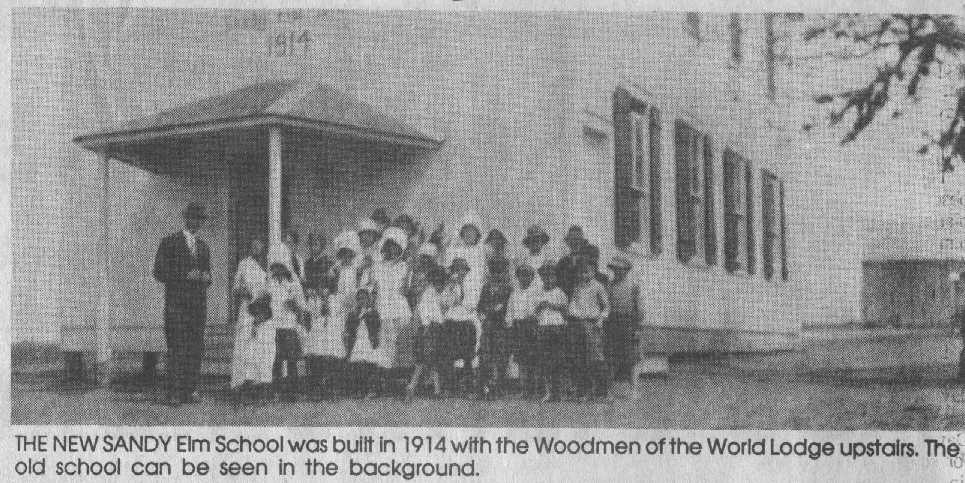
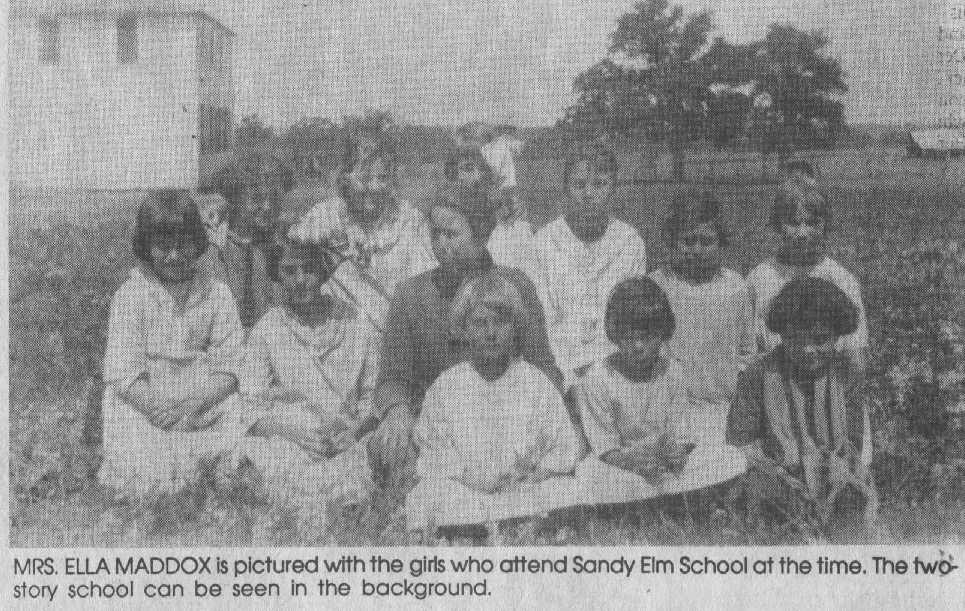
Lodge Important Part of Community
Sunday, April 7, 1991 Page 11AOn Aug. 18, 1898, a lodge was charted in a community called O'Daniel in southwestern Guadalupe County in Texas. This newly organized fraternal society was Lodge #229 and monthly meetings were held above the General Store and Post Office in O'Daniel.
The meetings were to conduct business and to have a short time of relaxed fellowship, but alcoholic beverages were strictly forbidden.
In the early 1900s an organization for the ladies was founded. Their name was Grove, and they met separately until they merged with the men in the 1950s.
In 1914, when the new Sandy Elm school house was built, the upper story or "Sky View" belonged to the Woodmen of the World Lodge #229.
Organized at O'Daniel only eight years after the Society was founded in Omaha, Neb., in 1890, Lodge #229 was strong and important in the community. At the heart of the society is God, family and country.
In 1923, a Woodmen of the World tuberculosis hospital was built in San Antonio. The Woodmen War Memorial Hospital gave free treatment for pulmonary tuberculosis to more than 4.900 Woodmen members before it closed in 1956 because of more modern methods of treatment.
Records in the archives of the home office in Omaha, Neb., show that Lodge #229 in O'Daniel was functional until Feb 16, 1940, but the record isn't clear which Lodge it consolidated with after that.
Now in their centennial year, Woodmen of the World has 177 lodges in southwest Texas, with Alice P. Cisneros the field representative in Seguin for Lodge #101.
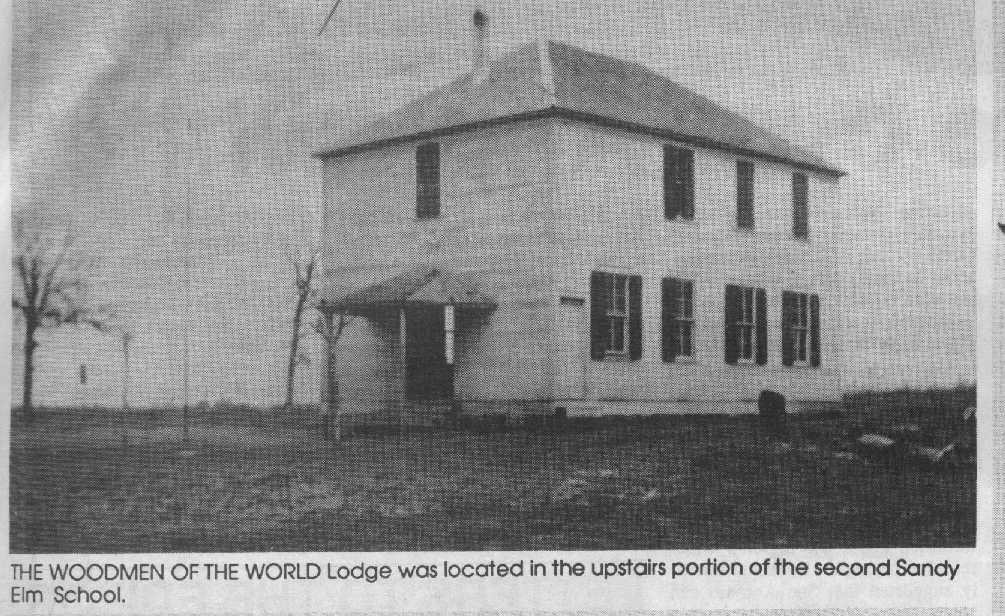
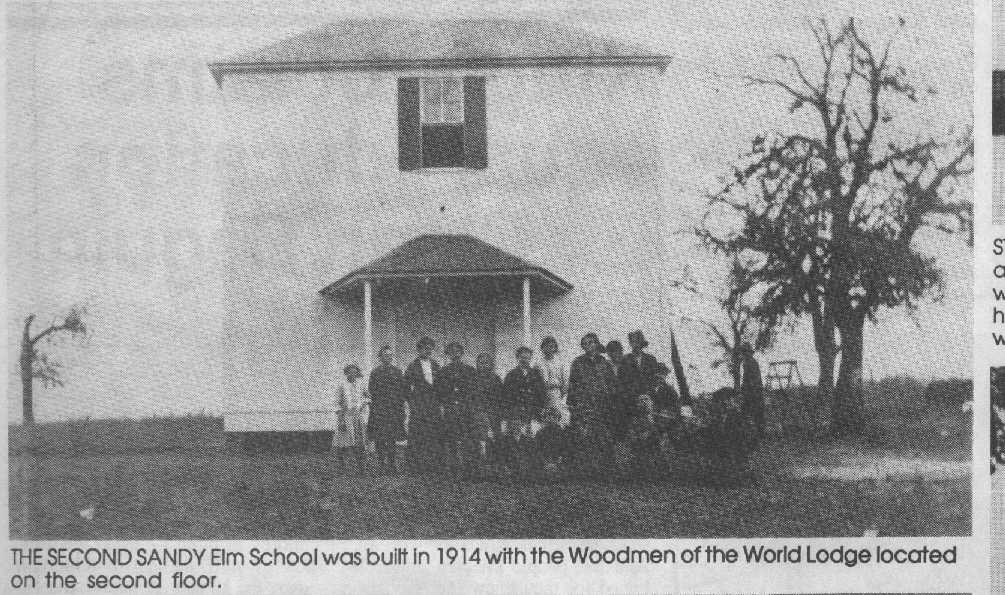
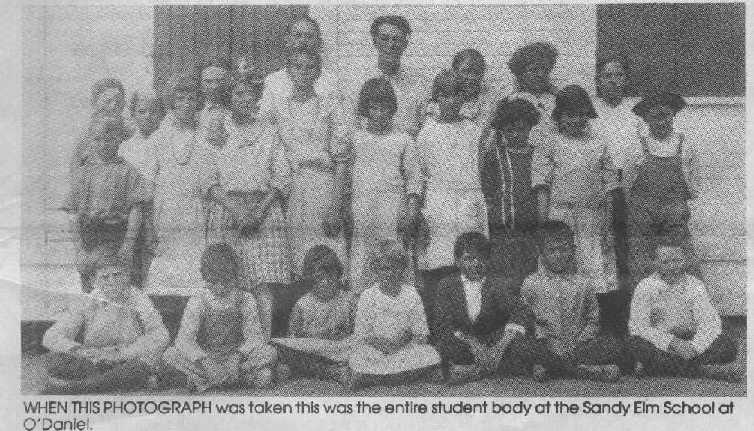
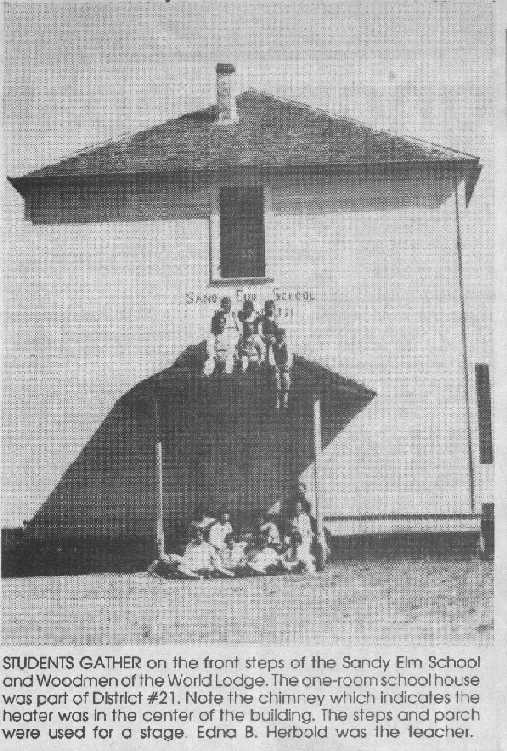
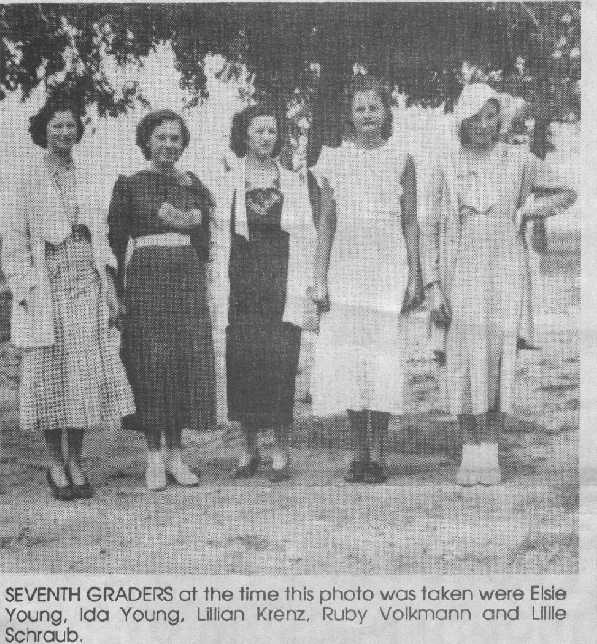
Former O'Daniel resident remembers life in small community
Thursday, April 11, 1991 Page 2As I remember O'Daniel, by Ruby Vorpahl Peterson
I am a first generation born Texan. My parents immigrated from Germany. In 1867 my father, Emil Vorpahl, was four years old when he and his family came over on a sailing ship. It was four months before the sailing ship landed at Indianola, Texas. There are only big pilings left at the site now.
My mother, Bertha Kleinschmidt, was 16 when she came over on a steam ship with her family in 1881. That trip only took two weeks and they landed at Baltimore, Maryland.
In 1886, my parents were married in Geronimo, Texas and then settled in O'Daniel, Texas. I was born in 1912, the last child of Email and Bertha Vorpahl.
I lived in the big white house across and down the road from the O'Daniel store. My father owned the store until the time I was 12 or so. My father's store was about 30'x40'. The floor space was made of wood. There were a lot of splinters in the floorboards. On each side of the building was a long counter.
It was a general store. Big barrels stood in the center of the room filled with flour, cornmeal, rice, beans, etc. On the sides of the walls were shelves where the canned goods and other staples were kept. No one ever dared to go behind the counter to get supplies except for the clerk.
There was a big heater in the rear of the store where men would usually come and sit around, spit and tell tall tales. School children would stop by and buy a nickel's worth of mixed candy.
In one corner was something like a platform. It had a banister around it with three or four steps up to it. There were places for boxes for mail. It was our post office, O'Daniel. Later on the post office was closed down and metal mailboxes were placed on posts across the road from the store and that is where the mail was delivered. The mailboxes are in the same location today.
I had to go to the mailbox everyday... that was a must! There were about eight or 10 mailboxes as I remember. Mr. Mellor, the mail carrier, would hand me our mail and I would run across the road to the store.
My brother Louis and my father would offer me mixed candy, but I would ask him for a dill pickle from the big gallon jar that was always on the counter. They were so good!
At Christmas time he always had big crates of fruit and mixed candy in the store.
My father owned the store before and during World War I. Times were hard then. My father helped many folks, black and white. Some paid him, some never did.
On Sunday afternoons, all the neighbors and cousins would come from all over. Germers, Schievelbeins, Krenzs, Hoermanns, Lambrechts and the Paces. My brother Edgar's wife, Erma, was a Pace.
Everyone was always dressed in their best because you must understand, there weren't too many places to go, or things to do. They would go by the Methodist Church, then by the old "cotton gin" and sing.
I liked the little Methodist Church. There was an altar bench in the church, low enough for me to sit on. I was a Baptist, of course, and I really thought the Methodist Church had that bench there especially for me.
I was about four years old. The preacher got a kick out of it and asked me to sing, "I'll be a Sunbeam for Jesus". I grew about six inches. My father was proud of me. My sister Julia thought I was a little angel, of course.
My father also ran the cotton gin for a while. The boys would climb around on the engines and play. It was closed down before my time. However, my brothers took pictures of the gin.
My sisters looked so pretty in their dresses and high white button shoes or gray high-heeled lace shoes and fishing out of the creek behind the mailboxes. They would wear pretty voile dresses with lace and satin ribbons. They wore hair ribbons to match.
I was the youngest of my family. My sisters were all in their teens and 20s and I was still in grade school.
When I saw my sisters look so grand in their beautiful clothes, I couldn't wait until I could "shed" my long black stockings, high-topped shoes and children's clothes. My dresses would be long waisted with big collars and mid-arm length sleeves. My sisters would also wear starched white cotton blouses and mid-calf length straight skirts that flared at the bottom or sometimes colored print dresses.
Hats were always a must for the women to wear to protect their faces from the hot sun. The men and boys would always wear white cotton shirts. The grown men would wear narrowed black bow ties. Yes, those days of the summer socials were always filled with laughter, stories and always food.
There were three brothers and six sisters in our family -- George, Louis, Edgar, Ida, Julia, Annie, Lillie, Velma and me. My sister Lillie died during the flu epidemic during World War I. She left two small baby boys.
Folklore has it that there were Indians living around the "red flint stones and mesquite tree hills", just south of the O'Daniel store. This hill was on our land. Cotton and corn were usually planted in that area.
In cotton picking time or hoeing corn, my sister Julia and her husband, Paul Schievelbein, would be right there, working together side-by-side in the fields. It was my job to baby-sit their children. Julia would spread a quilt on the big flint rocks, about six or eight feet long. She had two babies at this particular time. She would have sandwiches and lemonade there in the shade. I will never forget Julia.
Paul Schievelbein would pick up flint arrowheads and sometimes would find flint stones -- while working on the hill. he would give them to me and I would pick up some too. We put them in an old syrup can. There were so many different shapes. Paul would always tell me a story about each shape of the stones. He said the Indians would gather there on the hill and make arrowheads and knives. This hill was just south of our home, 600 or 700 feet. I have some of the arrowheads stored in an old metal lunch box. They are my proof that the story about the Indians was true.
As I grew older, maybe 13 or 14, I'd walk up there to the same flint hills and lie down to read or study, and would look up at the big fluffy white clouds, imagining the fluffy clouds were ice cream. I didn't dream then that time would come when I might be flying through those clouds some day in an airplane.
Sometimes a bi-lance would fly over from Randolph Field, which was built around that time. Sometimes, a plane would land on the sandy hill nearby. The planes would sit there a few minute and take off again.
I went to the new school house when the old one was torn down. The school was a two-story building with a high flagpole and a big concrete cistern around the back. The Woodmen of the World met upstairs for their lodge meetings. We never go to go up there.
We played volleyball, basketball and softball. We played around the old gravesites. There were no names on them. My cousin and I would either walk to school or we rode donkeys to school. The donkeys belonged to Paul and Eddie Hoermann. We would ride the donkeys without a saddle. My cousin was so fat that one day, she started sliding off the donkey and pulled me along with her. She fell on top of me. What a life.
There was a black family that lived up the road past the school. Their name was McIntyre. They had their own home and farm.
I remember when I was really young, my father, my sister Annie, and Paul Volkmann, my cousin, went to Seguin on business. It rained all day and all the creeks were out of their banks. Jerry McIntyre asked them to spend the night with them. They said the McIntyre family all treated them like royalty. The beds were so clean and in the morning they fixed them a good breakfast. By then the creeks had settled down and they went home.
There was another black family that lived in their own home and farm across the creek to the west. The father of that family was named Pink Waiters. They were nice too. The Waiters' children went to school at Sweet Home. They had their own farm, house and barn.
I remember the black lady that lived up near by the Hoermann place. She helped bring a bunch of babies into the world, including me. Her name was Angeline Dickinson. She would come and visit my mother. Mother would give her vegetables. She called my mother, "Ms Bette." She washed clothes for my mother after the older girls left home. She lived to be very old.
When I was 12 years old, there was a family living in the apartment over the store. He was an astrologist. People would come from miles around just to see him because he claimed he could communicate with the dead. People were curious and wanted to know " what was in the stars" for them. When my father found this out, he was furious and asked the man to leave.
I liked their little girl my age. She corresponded with me after they moved out of state. I still have a picture of her. Her name was Lucille.
Sometimes groups of gypsies would travel through the county. They had a covered wagon of sorts, but mostly the people would walk alongside. They came to O'Daniel one day and when they were coming up the road to our house, the older kids grabbed me and kept me in the house. Lore has it, they would sometimes kidnap a small child. The gypsies had a big black bear with them when I remember them on our place.
On the corner of the two roads that came together, there used to be a blacksmith shop. It was operated by the Toms boys. I don't remember how many, I just remember two of them working putting shoes on mules and horses. I can still hear that hammer hitting the anvil.
There were quite a few rattlesnakes around My brothers taught me not to be scared and told me how to protect myself if they weren't with me. There were always big grass weeds with yellow flowers growing around the barn.
One day, my father said, the yellow weeds needed hoeing. He was in front of me working when I heard the rattle of the rattlesnake. The snake was going to strike my father. I raised me hoe and brought it down on the snake (with about eight rattles on his tail) and cut his head off. My father was so surprised, he said, "Let's go to the house." I was about 10 or 11 years old.
There is no more room to write more. I could, but I just want to remember the good times and folks of O'Daniel, Texas.
Growing up in O'Daniel remembered fondly
Sunday, April 14, 1991 Page 1BReminiscences by Irene Timmermann of her early years in O'Daniel
I was born in a house behind the O'Daniel store on Dec 16, 1902. I was quite small when my dad had or managed the O'Daniel store which was a Grange Store. Both the store and our home have gone now. My dad was also postmaster there until 1905.
My mother and my two older brothers, Al and Harry, and my sister, Stella, went in the field to work and I would take my comb and brush to the store and Dad would comb my hair.
Another thing I remember was when my brothers and sisters would send me to the store to ask Dad for candy. They stood out side and would help me divide it. Of course, Dad knew this and there always was enough for all of us.
Ferdinand Schraub worked in the store with Dad and also boarded with my folks.
I started to school when I was eight-years-old, my first teacher was Mamie Smith. Then later, I remember Lydia Whitehead and Julia Anderson, who also boarded with my folks. We had almost a mile to walk to our one-room school, which had seven grades. We had an iron stove to keep us warm and we would all sit around the stove.
When it was real cold, since I was the little one, my Dad would wrap papers around my legs over my long underwear and then pull my long stocking over them. My legs were not cold but my feet were!
At recess some of the older boys would go to the store for water and there were His and Hers outhouses. At recess we also would play Mumble Pegs, Jacks and the older ones played baseball. They had no nice baseball bats, just a board or whatever they found.
There was a small graveyard on the grounds and when the phlox and bluebonnets were blooming we younger ones decorated the graves.
Later, a new school was built and it was two-storied. The Woodmen of the World Hall was on the second floor.
Our nearest neighbors were the Vorpahls, Ploegers, Youngs, Hoermanns, Lambrechts and two nice black families, the Pink Waiters and the Pitts Family, who helped my dad on the farm.
On Sunday we went to the Methodist Church. We always walked as it was about two blocks from our home. In summer we had church picnics and everyone brought food and we all ate together. It was in back of the church under the trees.
At Christmas we had a program and each child made a nice bow and said his or her speech. Later we each got a paper sack with apples, oranges, nuts and candy.
Also, some Sundays we went on hayrides with the neighbors and we would stop at the store to take pictures.
I also remember when we had a revival meeting at our church. When we got home my older brother asked me what I learned and my answer was, "I got religion." Later when he got to town he bought me a little Testament and I still have it.
While my folks were in La Vernia, Harry fell into the creek close to our home. He was a blond but when he got out he was a redhead.
Another time, also when our parents were not at home, Stella went wading and slipped so she went in the house, built a fire in the store with papers and tried to heat the iron to dry her clothes.
Also, Al, Stella and Harry (I was too small) were to chop cotton. They picked up small tin cans from the trash pile, went to the tank and made mud pygmies to float on the tank.
Another fun thing -- we had a large oak tree away from the house and at noon when my folks rested, we four kids went to the tree and crawled all over it. We marked the limbs New York, California, etc. and when we climbed in that tree we traveled all over!
We all had farms marked off with rocks and made men and animals out of corn stalks and other things for our farms. Boy, we had fun!!!
P.S. These ancient live oak tress are still there.
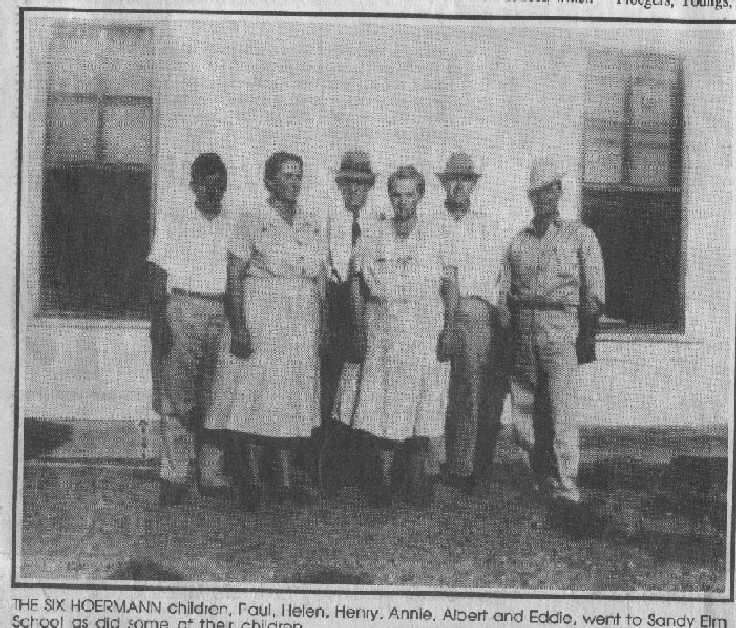
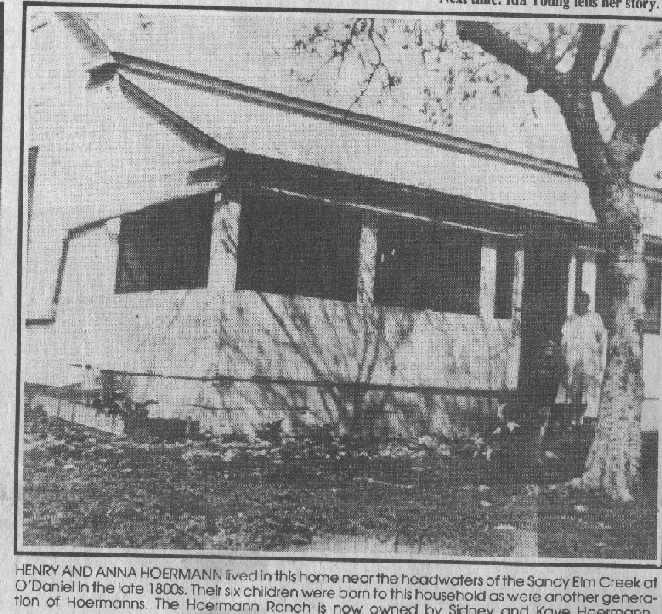
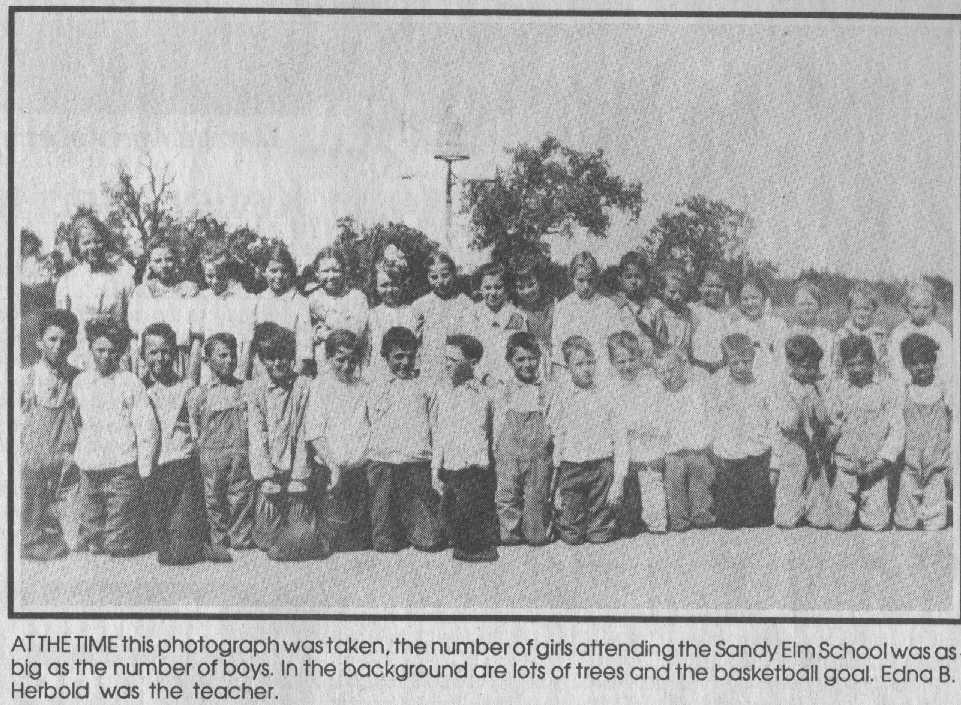
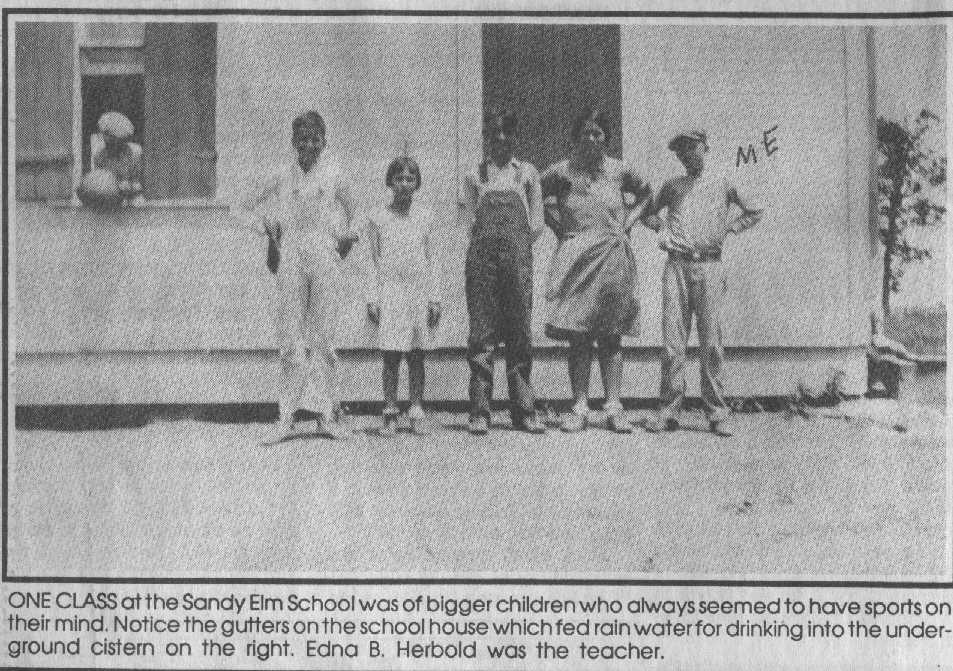
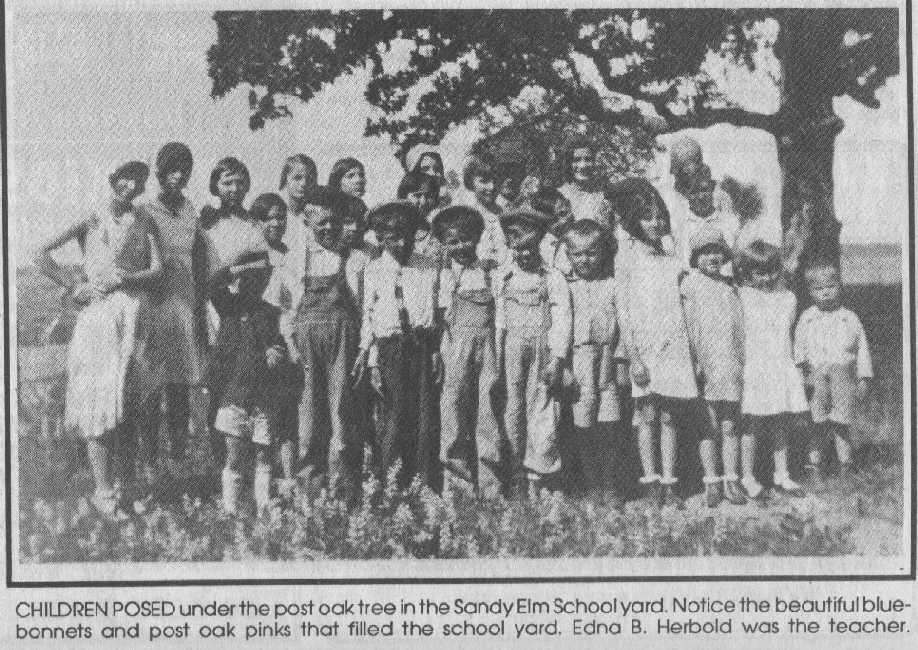
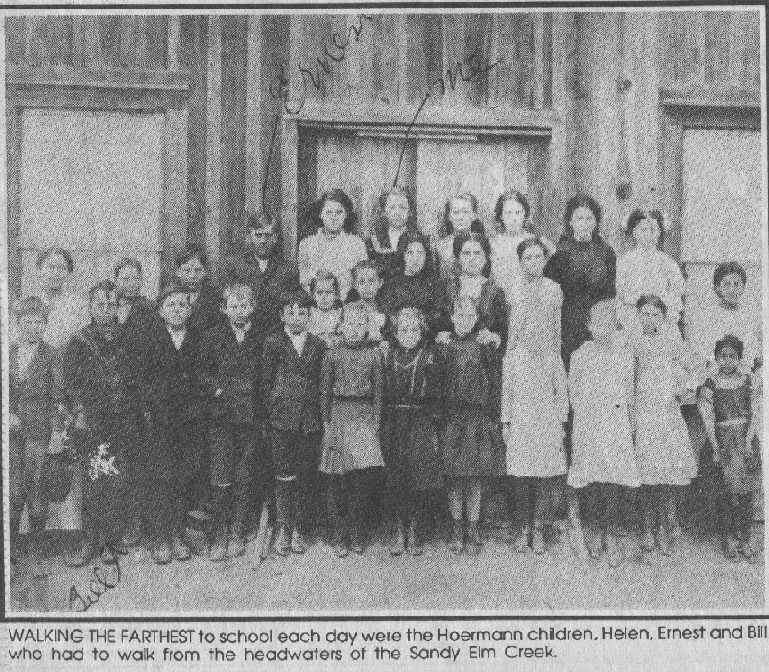
Former resident remembers minding the store at O'Daniel
Thursday, April 18, 1991 Page 11I Remember O'Daniel, by Ida Young
I was born a second generation O'Daniel resident. My grandparents Young owned the farm northwest of O'Daniel, just across the road.
My sister Elsa and I were brought into the world by Angelina Dickenson, a black midwife who delivered many babies in the area.
My parents, the Joe Youngs, were the last to own and operate the general store at O'Daniel. We lived in the house behind the store.
Edna Baenzinger lived with us for a while when she taught at Sandy Elm School Some other teachers I remember when I went to school were Zadie Smith, Valena Hemphill, and Ella Maddox. After I finished school at Sandy Elm, I graduated from Seguin High School.
We went to the Post Oak Evangelical Church. I was confirmed in the Sandy Elm School house the year the storm blew our church from its foundation. The Rev. Winters came from San Antonio to confirm us.
I remember a lot about the store we owned at O'Daniel. There were large bins for flour, sugar, beans, coffee and such staples. They were weighed in the amounts the customer wanted to buy. There were all kinds of canned good, large blocks of yellow cheese, all kinds of hard and other candies, along with the usual general merchandise.
My sister and I enjoyed trying on the high-topped button shoes. Elsa, my step-brother Hilmar Lange and I got to mind the store when Mama and Papa went to Seguin for supplies.
Harry Berger was a salesman for Smith and Linne Wholesale Grocers and later for C.W. Traeger. He'd come out to take the order, but the supplies had to be picked up in Seguin. Sometimes when it rained a lot, Papa would have to get them in a wagon because of the muddy roads.
We really had fun when we were in charge of the store. We enjoyed he candies, and also ran the pickup round and round. We spent a great deal of energy with rakes and brooms erasing the tire tracks.
The store closed in 1930 and the property sold to the Norwood family. The store building was torn down and the lumber was used at the new location in Seguin.
I have many fond memories of life at O'Daniel.
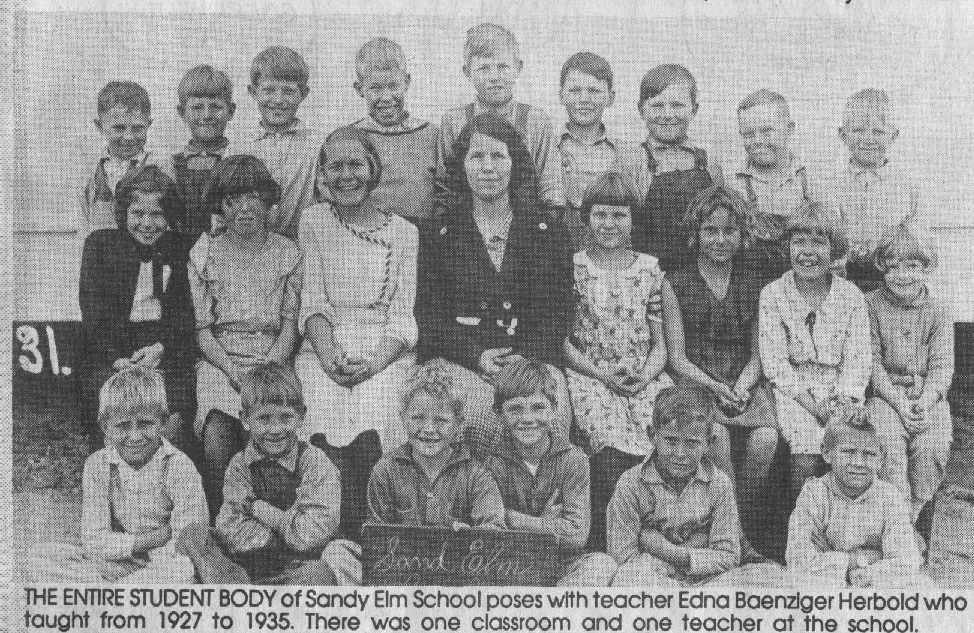
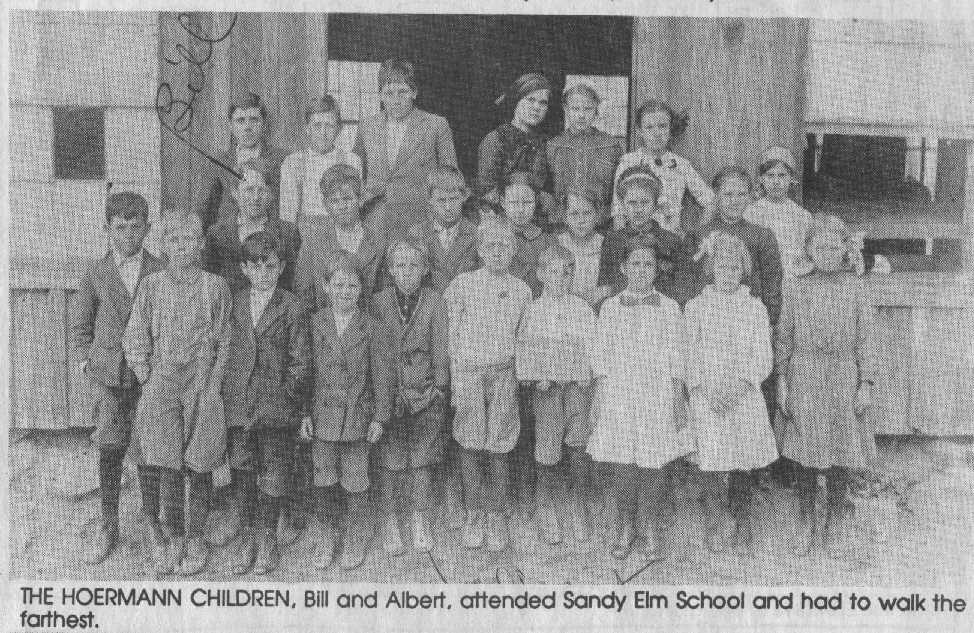
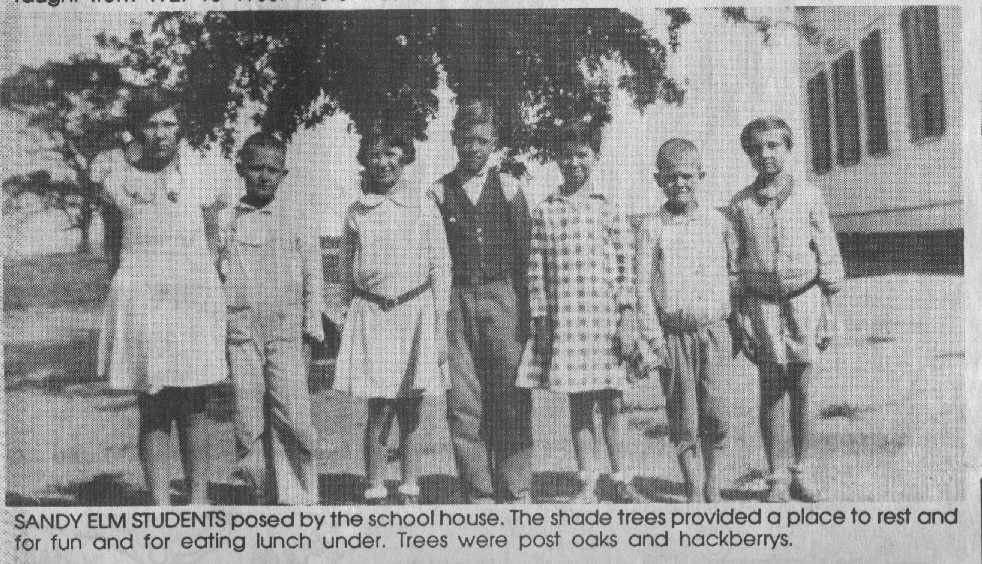
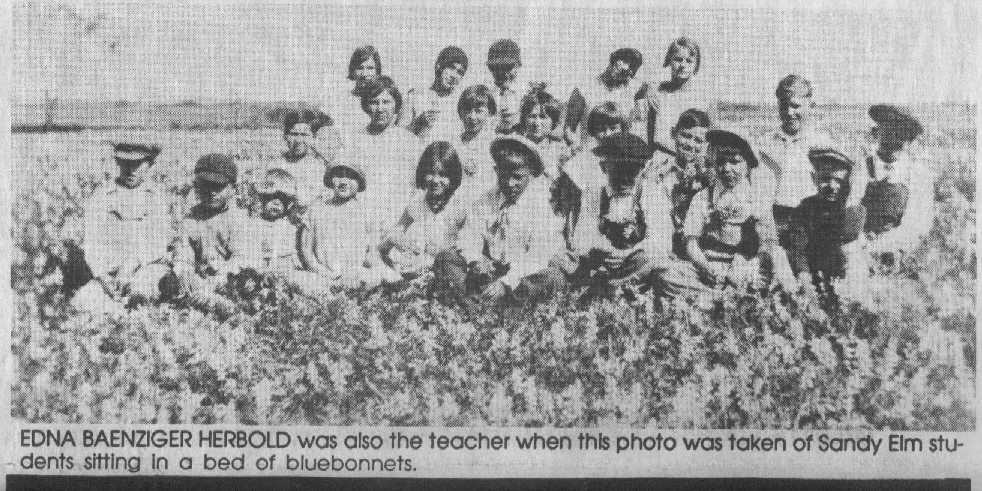
First Post Oak Church damaged by storm
Sunday, April 21, 1991 Page 3BThe Post Oak Evangelical Church was begun in the early 1880s by missionary Evangelicals from Wisconsin.
They met in the home of Ludwig Neumann. Later they worshipped in the Neumann Public School house across the road.
Neumann donated three acres of land for the church buildings and parsonage, which were dedicated Feb 21, 1886.
In 1929 a violent storm blew the church from its foundation.
A large tent was set up on the Joe Young property by the general store in O'Daniel, at the site of the O'Daniel Methodist Church. Twelve boys and girls were confirmed that year in the Sandy Elm School house. Later, the parsonage at Post Oak was renovated for worship.
In 1940, the congregation built the new church building, and 10 years later, the new parsonage. By this time the Evangelical Church had merged with the United Brethren, and the congregation became the Post Oak Evangelical United Brethren Church. In 1968 this denomination merged with the Methodists. Most of the Post Oak congregation transferred to the La Vernia United Methodist Church.
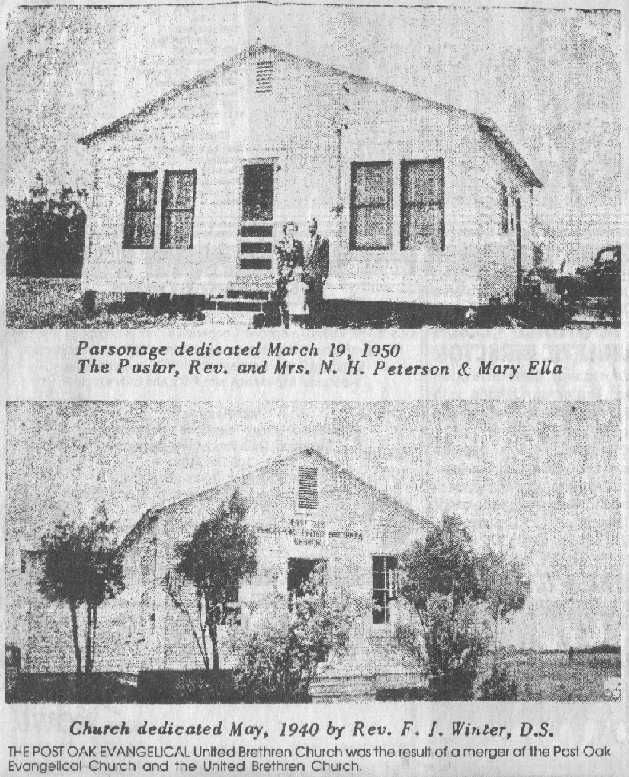
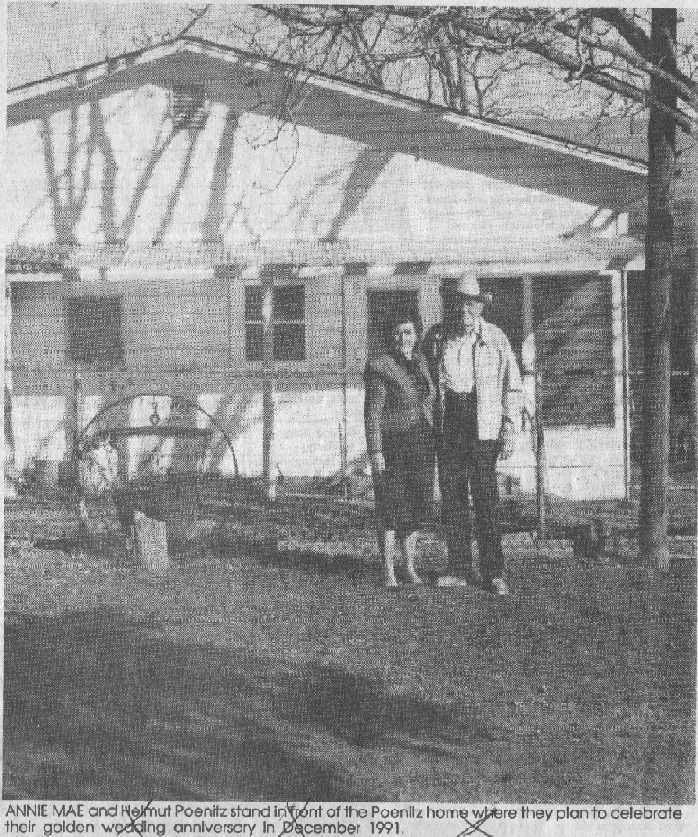
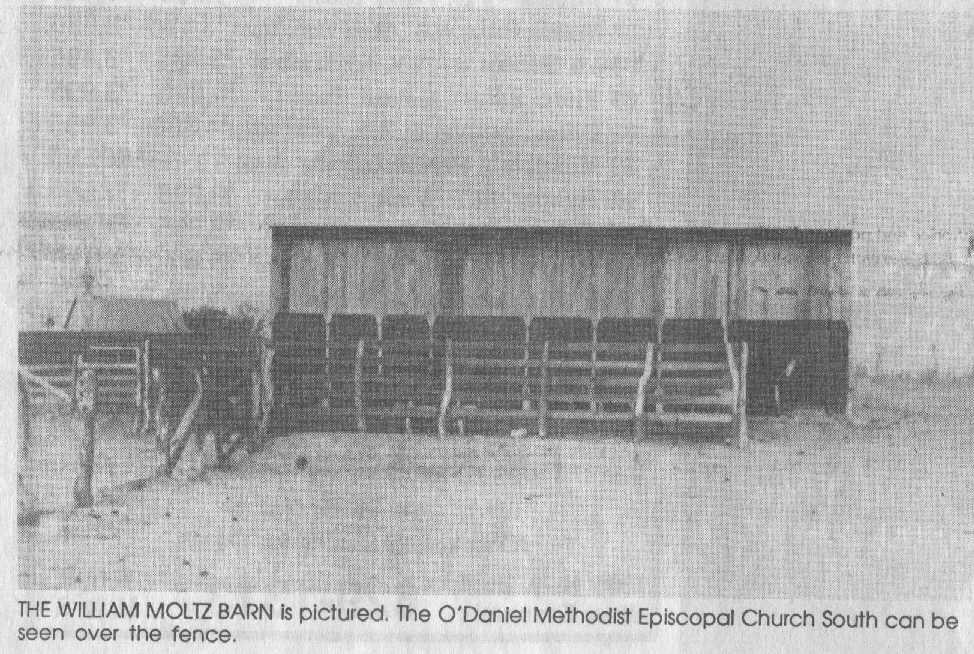
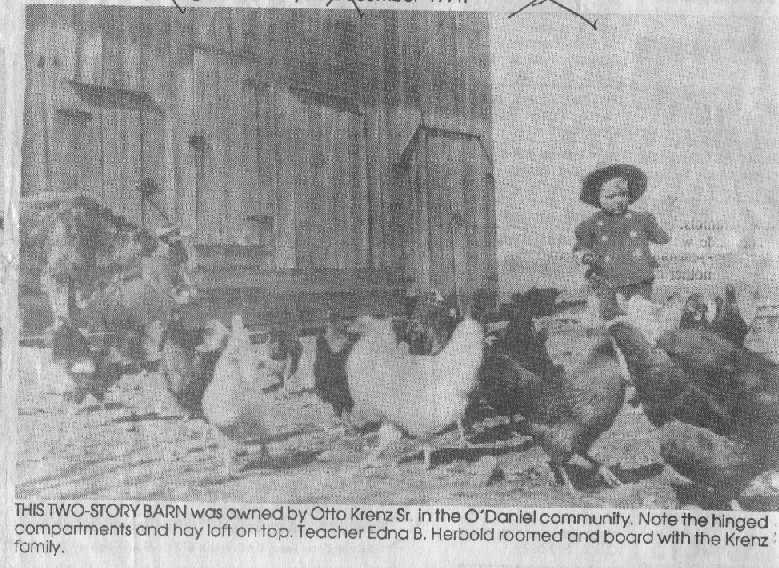
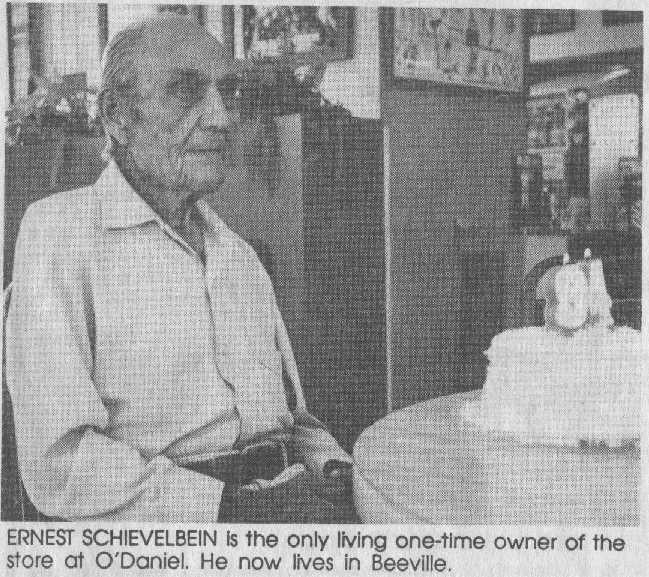
Marker unveiled for O'Daniel community
Sunday, April 28, 1991 Page 1BSunday, April 21, was dedication day for the historical marker which has been placed at the site of the community of O'Daniel near Seguin.
For several weeks, the Gazette-Enterprise and Nelda Kubala of Leon Studios have been chronicling the history of the O'Daniel community in stories and photos provided by Mrs. Kubala.
Sunday, April 21, was the climax of Mrs. Kubala's work as the marker was unveiled.
John Gesick, chairman of the Guadalupe County Historical Commission, gave the welcome and introduced County Judge Jim Sagebiel who introduced county commissioners, former county commissioner Tom Brown and Bill Turppa, head of the county's road and bridge department.
Gesick then read a letter form District Judge B.B. Schraub and introduced Seguin Postmaster Ed Petter and Mrs. Petter.
The invocation was given by Mrs. Kubala. master of the ceremonies was Marceil Coor-Pender from Pasadena, Calif. She introduced her cousin, Jan Coor-Pender Dodge from Berkeley, Calif. Their fathers were born at O'Daniel. Marceil's father, age 95, is still living.
The special music was by Alexa Norman, accompanied by Bonnie Cole on the keyboard. Alexa sang "Amazing Grace" and then led the group in singing revival hymns.
The historical marker was then unveiled and read. It reads as follows; "The community named for J.N. O'Daniel, teacher in 1885, had a one room 1877 school - Sandy Elm. Attendance reached 60 pupils. Graves in a corner of the yard numbered over 20; Nancy McBride's stone remains. The two story general store with post office in the rear, and a W.O.W. Lodge upstairs, was the center of the community activity. The Methodist Church, cotton gin and blacksmith shop were nearby. In 1914, a new school was built with the lodge meeting room upstairs. The post office closed in 1905; the store was gone by 1930; the school closed in the 1940s."
The master of the ceremonies asked for a show of hands of former students of Sandy Elm School and hands were raised all over the crowd. Attending also were Mildred Mueller Radtke, teacher at Sandy Elm School 1940 - 41, and former country school superintendent Ted Billnitzer and his wife Marie Jo Billnitzer.
The closing prayer was given by Mary Virginia Johnson, granddaughter of the last postmaster at O'Daniel, William Moltz, whose other three granddaughters, Doris Bentley, Carolyn Dyche, and Beverlyn DuBose, served refreshments.
The crowd numbering almost 200, came from Louisiana, California, Colorado, Nevada and in Texas from New Braunfels, Waco, Victoria, Houston, Bellaire, Bellville, La Vernia, Adkins, Pleasanton, Floresville, Marion, Seguin and neighboring communities.
